 Last summer I posted about a partial horse skull from Diamond Valley Lake that still had its deciduous premolars in place. Of course, if that horse had lived a little longer the deciduous teeth would have fallen out and been replaced with permanent teeth, with the remnant of the shed tooth left behind.The large tooth shown above is a shed deciduous premolar, probably the upper left dP4. Besides Max, for scale there is also a modern human deciduous premolar (P2 instead of P4, since humans only have 2 premolars) courtesy of my son Tim.Horses eat abrasive food such as grasses, and their teeth take a beating. By the time the 4th deciduous premolar is shed at around 3 years of age, it is worn to a nub. This is more apparent in an oblique view of the same tooth:
Last summer I posted about a partial horse skull from Diamond Valley Lake that still had its deciduous premolars in place. Of course, if that horse had lived a little longer the deciduous teeth would have fallen out and been replaced with permanent teeth, with the remnant of the shed tooth left behind.The large tooth shown above is a shed deciduous premolar, probably the upper left dP4. Besides Max, for scale there is also a modern human deciduous premolar (P2 instead of P4, since humans only have 2 premolars) courtesy of my son Tim.Horses eat abrasive food such as grasses, and their teeth take a beating. By the time the 4th deciduous premolar is shed at around 3 years of age, it is worn to a nub. This is more apparent in an oblique view of the same tooth:  In the Diamond Valley Lake collections we only have a few shed deciduous horse teeth. Many animals don't live enough to shed their teeth, and if they do live that long, by the time the teeth are shed they're worn so thin that they aren't as likely to survive to become fossils as a more complete tooth.This tooth will be on display in the "Stories from Bones" exhibit, opening at Western Science Center on October 31.
In the Diamond Valley Lake collections we only have a few shed deciduous horse teeth. Many animals don't live enough to shed their teeth, and if they do live that long, by the time the teeth are shed they're worn so thin that they aren't as likely to survive to become fossils as a more complete tooth.This tooth will be on display in the "Stories from Bones" exhibit, opening at Western Science Center on October 31.
Fossil Friday - Alamosaurus neck vertebrae
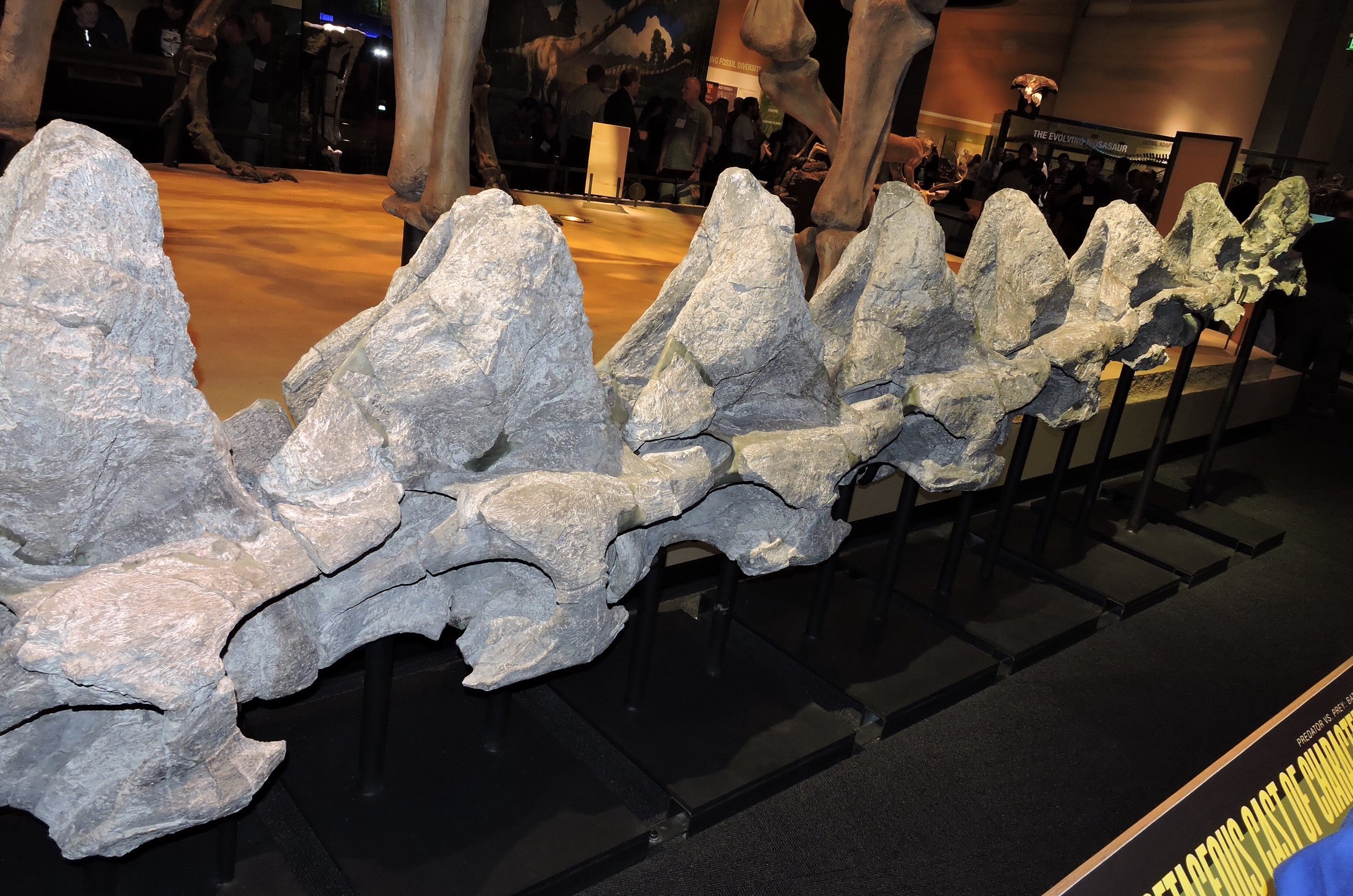 This week I've been attending the annual Society of Vertebrate Paleontology (SVP) meeting, which is being held this year in Dallas. SVP usually is held in a city with a natural history museum, and on Wednesday night the local museum will generally host a welcome reception. So for this week's Fossil Friday I photographed one of the highlights of the Perot Museum of Nature and Science's exhibits, the neck of Alamosaurus.Alamosaurus was a large sauropod dinosaur that has been found in Cretaceous sediments in the southwestern United States; this specimen is from Big Bend National Park in Texas. While not as famous as its older Jurassic relatives like Brontosaurus, Alamosaurus was just as large and impressive. This is easy to see when you realize that in the photo above you can only see 8 neck vertebrae!This image is taken as if you're standing near the base of the neck on the right side, looking forward, so the head would be toward the far right. There were at least a few more vertebrae at the base of the skull that were not preserved in this specimen, and more at the base of the neck as well. In fact, there is a ninth vertebra on exhibit, but the neck is so large that with the reception crowds I couldn't get far enough away to get all nine vertebrae in one photo from this angle. So here are all nine, looking from the front to the back:
This week I've been attending the annual Society of Vertebrate Paleontology (SVP) meeting, which is being held this year in Dallas. SVP usually is held in a city with a natural history museum, and on Wednesday night the local museum will generally host a welcome reception. So for this week's Fossil Friday I photographed one of the highlights of the Perot Museum of Nature and Science's exhibits, the neck of Alamosaurus.Alamosaurus was a large sauropod dinosaur that has been found in Cretaceous sediments in the southwestern United States; this specimen is from Big Bend National Park in Texas. While not as famous as its older Jurassic relatives like Brontosaurus, Alamosaurus was just as large and impressive. This is easy to see when you realize that in the photo above you can only see 8 neck vertebrae!This image is taken as if you're standing near the base of the neck on the right side, looking forward, so the head would be toward the far right. There were at least a few more vertebrae at the base of the skull that were not preserved in this specimen, and more at the base of the neck as well. In fact, there is a ninth vertebra on exhibit, but the neck is so large that with the reception crowds I couldn't get far enough away to get all nine vertebrae in one photo from this angle. So here are all nine, looking from the front to the back:  The Perot Museum asked Research Casting International to produce a cast reconstruction of Alamosaurus based on these vertebrae and other Alamosaurus specimens. The cast is also on exhibit:
The Perot Museum asked Research Casting International to produce a cast reconstruction of Alamosaurus based on these vertebrae and other Alamosaurus specimens. The cast is also on exhibit: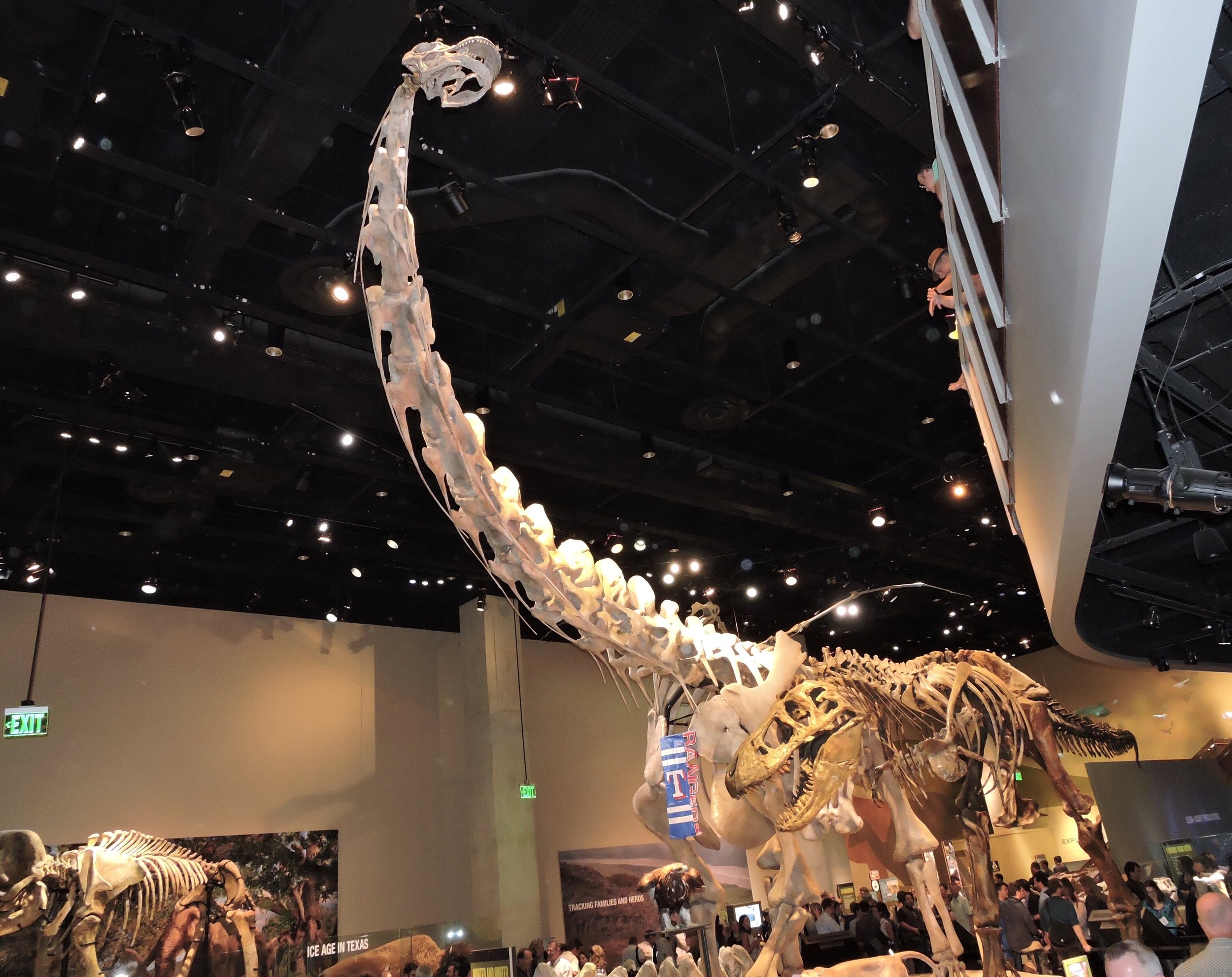 The people standing around the exhibit give an idea of scale. If that's not enough, that little theropod dinosaur standing beside Alamosaurus is Tyrannosaurus, and a Columbian mammoth is just visible at the lower left. By any standards, Alamosaurus was a huge animal!For more abut Alamosaurus, and to see photos of this specimen in the field, visit the SV-POW! blog.
The people standing around the exhibit give an idea of scale. If that's not enough, that little theropod dinosaur standing beside Alamosaurus is Tyrannosaurus, and a Columbian mammoth is just visible at the lower left. By any standards, Alamosaurus was a huge animal!For more abut Alamosaurus, and to see photos of this specimen in the field, visit the SV-POW! blog.
Fossil Friday - badger ulna
 It happens that last Tuesday, October 6, was National Badger Day in Britain. While the European badger Meles meles does not occur in North America, why should that stop us from honoring badgers? The American badger Taxidea taxus (above at The Living Desert Zoo) is only distantly related to the European badger, but it still goes by the common name of "badger", and that's good enough for me!Taxidea is widespread in North America today, so it's no surprise that is occasionally turns up in Pleistocene deposits. A handful of badger bones were found in the Diamond Valley Lake excavations, including this right ulna:
It happens that last Tuesday, October 6, was National Badger Day in Britain. While the European badger Meles meles does not occur in North America, why should that stop us from honoring badgers? The American badger Taxidea taxus (above at The Living Desert Zoo) is only distantly related to the European badger, but it still goes by the common name of "badger", and that's good enough for me!Taxidea is widespread in North America today, so it's no surprise that is occasionally turns up in Pleistocene deposits. A handful of badger bones were found in the Diamond Valley Lake excavations, including this right ulna: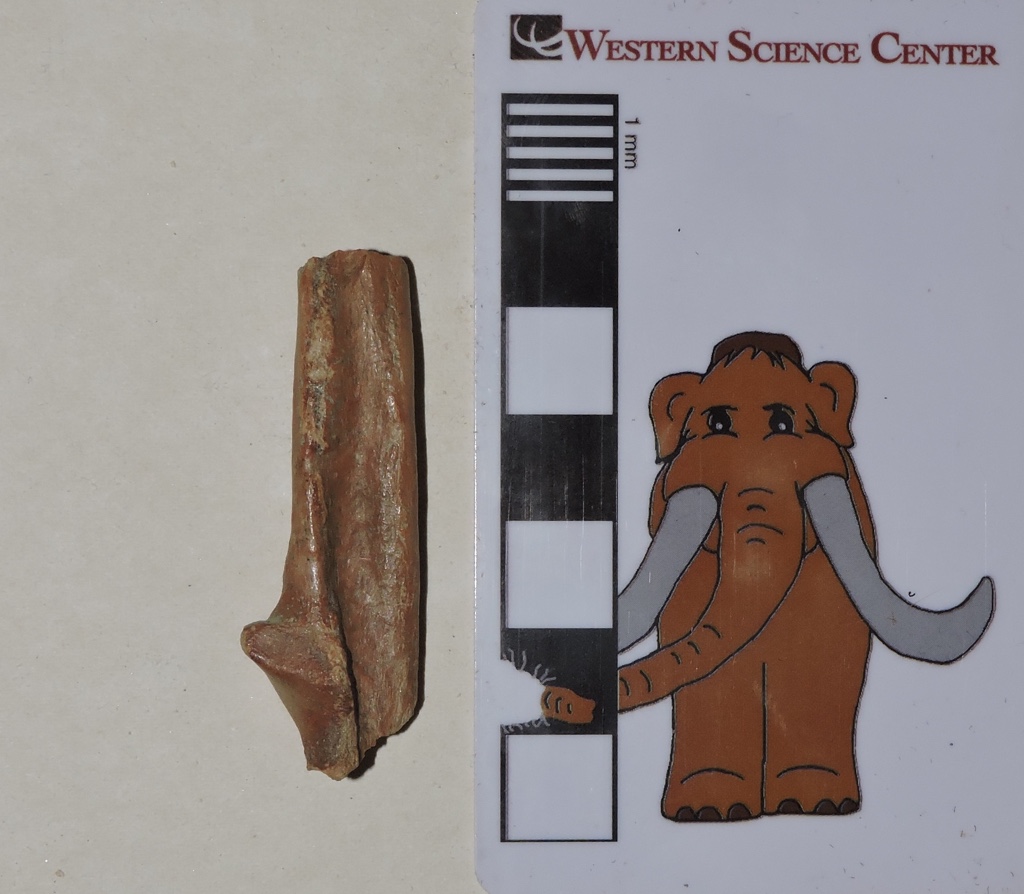
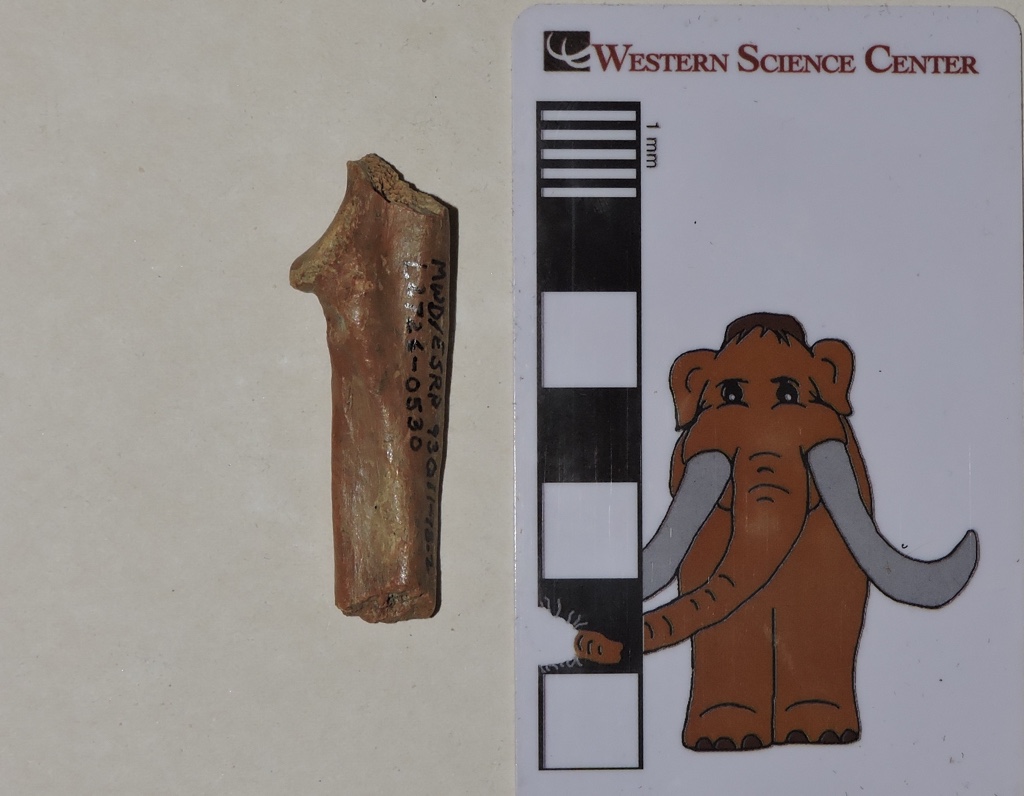 This fragment represents roughly the middle third of the ulna, one of the bones in the forearm. If that doesn't seem like much, keep in mind that badger bones make up roughly 0.0015% of the bones collected from the Diamond Valley Lake deposits, so even with such a small piece we're doing pretty well!
This fragment represents roughly the middle third of the ulna, one of the bones in the forearm. If that doesn't seem like much, keep in mind that badger bones make up roughly 0.0015% of the bones collected from the Diamond Valley Lake deposits, so even with such a small piece we're doing pretty well!
Fossil Friday - deer metacarpal
 One point I often come back to is how the Pleistocene fauna is in many ways so similar to today's fauna. Geologically speaking, the Ice Age is the recent past; many of the species alive then are still with us today.The bone shown above is the right metacarpal (forefoot bone) of a deer from the genus Odocoileus. Odocoileus is the most common large wild mammal in North America today, with the white-tailed deer O. virginianus found through most of the continent and into South America, and the mule deer O. hemionus ranging throughout western North America. While mule deer tend to be a bit larger than white-tailed deer (at least today), it's difficult if not impossible to distinguish between them based on limited remains such as this.This metacarpal is incomplete, with the proximal portion (closest to the wrist) broken off. The image above is in anterior view, while below is the posterior view:
One point I often come back to is how the Pleistocene fauna is in many ways so similar to today's fauna. Geologically speaking, the Ice Age is the recent past; many of the species alive then are still with us today.The bone shown above is the right metacarpal (forefoot bone) of a deer from the genus Odocoileus. Odocoileus is the most common large wild mammal in North America today, with the white-tailed deer O. virginianus found through most of the continent and into South America, and the mule deer O. hemionus ranging throughout western North America. While mule deer tend to be a bit larger than white-tailed deer (at least today), it's difficult if not impossible to distinguish between them based on limited remains such as this.This metacarpal is incomplete, with the proximal portion (closest to the wrist) broken off. The image above is in anterior view, while below is the posterior view: At the distal end of the bone, note that there are two articulations. Deer are members of the Family Cervidae, which are in the Order Artiodactyla. Like their relatives the Bovidae (cattle and their kin), Camelidae (camels), and many other artiodactyl groups, deer have two digits on each foot, digits III and IV (the middle and ring fingers on the hand, and the equivalent toes on the foot).Deer were not a major component of the fossil fauna at Diamond Valley Lake; horses, bison, camels and even mastodons are more common as fossils in these deposits. Nevertheless, they were common enough for multiple specimens to show up in the sample.
At the distal end of the bone, note that there are two articulations. Deer are members of the Family Cervidae, which are in the Order Artiodactyla. Like their relatives the Bovidae (cattle and their kin), Camelidae (camels), and many other artiodactyl groups, deer have two digits on each foot, digits III and IV (the middle and ring fingers on the hand, and the equivalent toes on the foot).Deer were not a major component of the fossil fauna at Diamond Valley Lake; horses, bison, camels and even mastodons are more common as fossils in these deposits. Nevertheless, they were common enough for multiple specimens to show up in the sample.
Fossil Friday - bighorn sheep toe bone
 Earlier this week Western Science Center received a small collection of fossils recovered by Paleo Solutions from Bureau of Land Management property near Desert Center in eastern Riverside County. While the material was limited, some was identifiable, including a few unusual pieces.This particular specimen is the first phalanx (toe bone) from what appears to be a bighorn sheep, Ovis canadensis, identified as such in Raum et al., 2014 (modern example below from a herd at Badlands National Park):
Earlier this week Western Science Center received a small collection of fossils recovered by Paleo Solutions from Bureau of Land Management property near Desert Center in eastern Riverside County. While the material was limited, some was identifiable, including a few unusual pieces.This particular specimen is the first phalanx (toe bone) from what appears to be a bighorn sheep, Ovis canadensis, identified as such in Raum et al., 2014 (modern example below from a herd at Badlands National Park): Historically bighorn sheep were widespread in the mountains and deserts of the American west, although their populations are now greatly reduced. There are still several hundred living in Joshua Tree National Park, not far from where this fossil was found.Fossil bighorn sheep do not seem to be particularly common; this is the only one in the WSC collection (as far as we know). This specimen is most likely Pleistocene (rather than something more recent) because extinct Pleistocene animals such as Smilodon were found in the same deposit.Reference: Raum, J., Aron, G. L., and Reynolds, R. E., 2014. Vertebrate fossils from Desert Center, Chuckwalla Valley, California. In R. E. Reynolds (Ed.), Not a Drop Left to Drink, California State University Desert Studies Center 2014 Desert Symposium: 68-70.
Historically bighorn sheep were widespread in the mountains and deserts of the American west, although their populations are now greatly reduced. There are still several hundred living in Joshua Tree National Park, not far from where this fossil was found.Fossil bighorn sheep do not seem to be particularly common; this is the only one in the WSC collection (as far as we know). This specimen is most likely Pleistocene (rather than something more recent) because extinct Pleistocene animals such as Smilodon were found in the same deposit.Reference: Raum, J., Aron, G. L., and Reynolds, R. E., 2014. Vertebrate fossils from Desert Center, Chuckwalla Valley, California. In R. E. Reynolds (Ed.), Not a Drop Left to Drink, California State University Desert Studies Center 2014 Desert Symposium: 68-70.
Fossil Friday - horse metatarsal
 While the bulk of the Western Science Center's paleontology collection comes from Diamond Valley Lake, we have significant collections from other localities. One of the most interesting collections comes from Southern California Edison's El Casco Substation in northern Riverside County. This material, while probably still Pleistocene, is well over a million years old, about 4 to 6 times older than anything recovered from Diamond Valley Lake.Horses are among the most common remains from El Casco. Shown at the top is a horse left metatarsal (foot bone), seen in anterior view. The bone is lying on its side, with the proximal end (closest to the ankle) on the right and the distal end (closest to the toe) on the left. The bone is somewhat deformed, so even though this is anterior view, part of the left side is visible (the edge closest to the scale bar). Notice that the bone looks a bit swollen at one point, adjacent to where Max the Mastodon is holding the scale bar.Here's the same bone in posterior view:
While the bulk of the Western Science Center's paleontology collection comes from Diamond Valley Lake, we have significant collections from other localities. One of the most interesting collections comes from Southern California Edison's El Casco Substation in northern Riverside County. This material, while probably still Pleistocene, is well over a million years old, about 4 to 6 times older than anything recovered from Diamond Valley Lake.Horses are among the most common remains from El Casco. Shown at the top is a horse left metatarsal (foot bone), seen in anterior view. The bone is lying on its side, with the proximal end (closest to the ankle) on the right and the distal end (closest to the toe) on the left. The bone is somewhat deformed, so even though this is anterior view, part of the left side is visible (the edge closest to the scale bar). Notice that the bone looks a bit swollen at one point, adjacent to where Max the Mastodon is holding the scale bar.Here's the same bone in posterior view: Again, the proximal end of the bone is on the right. In this view we can see that three bones are actually present, one large bone in the middle and a slender bone (commonly called "splint bones") on each side. In fact, all three of these bones are metatarsals.All modern horses in the genus Equus (and fossil Equus like this one) have a single functional toe on each foot. Like all mammals, horse ancestors had five digits on each hand and foot, but over time most of those digits have been lost. The one remaining functional digit is the third one, the middle finger on the hand and middle toe on the foot. These are attached to the 3rd metacarpal (hand) and 3rd metatarsal (foot).But what about those splint bones? Well, horses may only have one functional toe on each foot, but they still have remnants of the second and fourth metacarpals and metatarsals, which have not yet been completely lost. In the bone shown above, from the top you can see the 4th metatarsal, the 3rd metatarsal (by far the largest), and the 2nd metatarsal. The swollen area that is so visible in the top photo occurs near the distal tip of the 4th metatarsal, more clearly visible in lateral view:
Again, the proximal end of the bone is on the right. In this view we can see that three bones are actually present, one large bone in the middle and a slender bone (commonly called "splint bones") on each side. In fact, all three of these bones are metatarsals.All modern horses in the genus Equus (and fossil Equus like this one) have a single functional toe on each foot. Like all mammals, horse ancestors had five digits on each hand and foot, but over time most of those digits have been lost. The one remaining functional digit is the third one, the middle finger on the hand and middle toe on the foot. These are attached to the 3rd metacarpal (hand) and 3rd metatarsal (foot).But what about those splint bones? Well, horses may only have one functional toe on each foot, but they still have remnants of the second and fourth metacarpals and metatarsals, which have not yet been completely lost. In the bone shown above, from the top you can see the 4th metatarsal, the 3rd metatarsal (by far the largest), and the 2nd metatarsal. The swollen area that is so visible in the top photo occurs near the distal tip of the 4th metatarsal, more clearly visible in lateral view: The distal tip of the 4th metatarsal is fused onto the side of the 3rd metatarsal. This is a pathological condition, is is likely a healed fracture of one or both of these bones. In medial view the 2nd metatarsal shows the normal condition, where it lies close against the 3rd metatarsal but with no fusion at the distal end:
The distal tip of the 4th metatarsal is fused onto the side of the 3rd metatarsal. This is a pathological condition, is is likely a healed fracture of one or both of these bones. In medial view the 2nd metatarsal shows the normal condition, where it lies close against the 3rd metatarsal but with no fusion at the distal end: This injury was clearly not fatal, since it healed. There's no telling what caused the injury, but some type of blow to the outside of the foot is possible; maybe it was kicked or stepped on by another horse. But it does give us a snapshot, if an incomplete one, into the life of this horse.This specimen, along with many others in our collection, will be on display in our new exhibit Stories from Bones, which opens at the Western Science Center on October 31.
This injury was clearly not fatal, since it healed. There's no telling what caused the injury, but some type of blow to the outside of the foot is possible; maybe it was kicked or stepped on by another horse. But it does give us a snapshot, if an incomplete one, into the life of this horse.This specimen, along with many others in our collection, will be on display in our new exhibit Stories from Bones, which opens at the Western Science Center on October 31.
Fossil Friday - mammoth molar
 After a few weeks of focusing on mastodon remains, it's worth remembering that there were two different species of proboscideans at Diamond Valley Lake. While mastodon remains are quite common, Columbian mammoths (Mammuthus columbi) were also present.This specimen is a lower left 1st or 2nd molar of M. columbi, discovered during the early years of the DVL excavations. Like the closely related Asian elephant, mammoths had enamel that is folded multiple times, wearing to produce a series of raised transverse enamel ridges in occlusal view. Like other advanced proboscideans mammoths replaced their teeth sequentially, so the front of the tooth (on the right in the image above) is more heavily worn that the back of the tooth. In fact, the last enamel ridge is essentially unworn, so this tooth had probably not quite completely erupted.A cast of this tooth is on permanent exhibit at the Western Science Center, as a touchable display allowing visitors to compare the very different occlusal surfaces of mammoth and mastodon teeth. As it happens, we're also auctioning off an additional cast of this tooth (below) tomorrow night at our annual Science Under the Stars fundraiser.
After a few weeks of focusing on mastodon remains, it's worth remembering that there were two different species of proboscideans at Diamond Valley Lake. While mastodon remains are quite common, Columbian mammoths (Mammuthus columbi) were also present.This specimen is a lower left 1st or 2nd molar of M. columbi, discovered during the early years of the DVL excavations. Like the closely related Asian elephant, mammoths had enamel that is folded multiple times, wearing to produce a series of raised transverse enamel ridges in occlusal view. Like other advanced proboscideans mammoths replaced their teeth sequentially, so the front of the tooth (on the right in the image above) is more heavily worn that the back of the tooth. In fact, the last enamel ridge is essentially unworn, so this tooth had probably not quite completely erupted.A cast of this tooth is on permanent exhibit at the Western Science Center, as a touchable display allowing visitors to compare the very different occlusal surfaces of mammoth and mastodon teeth. As it happens, we're also auctioning off an additional cast of this tooth (below) tomorrow night at our annual Science Under the Stars fundraiser.
Fossil Friday - Max's mandible, CT-edition
 Last week we took Max to California Imaging and Diagnostics in Hemet, who donated a some time on their CT scanner to scan the lower jaw of Max the mastodon. A couple of days later CID provided us with disks with the scan data, and we've finally had a chance to start examining them. If you're unfamiliar with CT scans, the term is short for X-ray computed tomography. CT scans take a large number of X-ray images from multiple angles. A computer can then combine those images to make cross-section X-ray slices through the object. The slices can be stacked to make a digital 3D model of the object, or removed to examine the internal structure at any particular slice. It's an invaluable, non-destructive method of examining the inside of an object.I've uploaded an initial video of the slices of Max's jaw. The slices are transverse, run anterior to posterior, and are viewed facing anteriorly. Basically, imagine standing behind the jaw looking forward, and seeing cross-sections of the jaw gradually getting closer to you:http://www.youtube.com/watch?v=hK8c5pAgUrsSince the video runs front to back, the first thing you see is the anterior tip of the jaw. (Well, actually the the first thing is the plaster cradle the jaw is sitting on, then the tip of the jaw.) As you move back, you pass though the mandibular symphysis where the two haves of the jaw are joined, through the teeth, and then to the coronoid process and mandibular condyles (the condyles are incompletely shown, because the jaw was a bit to large for the scanning area).There are several slices that have especially noteworthy features. This is about 4 seconds into the video:
Last week we took Max to California Imaging and Diagnostics in Hemet, who donated a some time on their CT scanner to scan the lower jaw of Max the mastodon. A couple of days later CID provided us with disks with the scan data, and we've finally had a chance to start examining them. If you're unfamiliar with CT scans, the term is short for X-ray computed tomography. CT scans take a large number of X-ray images from multiple angles. A computer can then combine those images to make cross-section X-ray slices through the object. The slices can be stacked to make a digital 3D model of the object, or removed to examine the internal structure at any particular slice. It's an invaluable, non-destructive method of examining the inside of an object.I've uploaded an initial video of the slices of Max's jaw. The slices are transverse, run anterior to posterior, and are viewed facing anteriorly. Basically, imagine standing behind the jaw looking forward, and seeing cross-sections of the jaw gradually getting closer to you:http://www.youtube.com/watch?v=hK8c5pAgUrsSince the video runs front to back, the first thing you see is the anterior tip of the jaw. (Well, actually the the first thing is the plaster cradle the jaw is sitting on, then the tip of the jaw.) As you move back, you pass though the mandibular symphysis where the two haves of the jaw are joined, through the teeth, and then to the coronoid process and mandibular condyles (the condyles are incompletely shown, because the jaw was a bit to large for the scanning area).There are several slices that have especially noteworthy features. This is about 4 seconds into the video: The image of the jaw on the right is for orientation; the purple line is the approximate location of the slice. The blue arrow is pointing the pathological bone growth near the tip of the right dentary. Inside the bone, there are a series of fractures next to this bony growth, one of which is marked with the green arrow. I'm not sure if they are actually associated with the growth, or if they occurred after burial.Moving a little further back, to about 6 seconds:
The image of the jaw on the right is for orientation; the purple line is the approximate location of the slice. The blue arrow is pointing the pathological bone growth near the tip of the right dentary. Inside the bone, there are a series of fractures next to this bony growth, one of which is marked with the green arrow. I'm not sure if they are actually associated with the growth, or if they occurred after burial.Moving a little further back, to about 6 seconds: We're now behind the bony growth, but its effects are still present. The blue arrow is pointing to a foramen (a passage for nerves or blood vessels) that has been displaced anteriorly and ventrally, apparently in response to the growth. The green arrow is pointing to the mandibular symphysis, where the left and right dentaries are joined together. This was a surprise to me. These bones fuse together in older animals, obscuring the line of fusion. Max was a fully mature mastodon, middle aged at least. I would expect the symphysis to be completely fused, and on the outside it is; there's no trace of the symphysis on the outside of the bone. Yet inside they're still unfused. Is this typical of mastodons, or the Max's symphysis never fuse (or pop open) due to the beating his jaw apparently went through?Moving further back, to about 8 seconds:
We're now behind the bony growth, but its effects are still present. The blue arrow is pointing to a foramen (a passage for nerves or blood vessels) that has been displaced anteriorly and ventrally, apparently in response to the growth. The green arrow is pointing to the mandibular symphysis, where the left and right dentaries are joined together. This was a surprise to me. These bones fuse together in older animals, obscuring the line of fusion. Max was a fully mature mastodon, middle aged at least. I would expect the symphysis to be completely fused, and on the outside it is; there's no trace of the symphysis on the outside of the bone. Yet inside they're still unfused. Is this typical of mastodons, or the Max's symphysis never fuse (or pop open) due to the beating his jaw apparently went through?Moving further back, to about 8 seconds: This slice shows how much that foramen was displaced, when compared to the left dentary (blue arrows). It's also clear that the dentary is still messed up well behind the bony growth; note how asymmetrical the two dentaries are on the dorsal surface (they should be nearly mirror images). In fact, the entire mandible is quite asymmetrical. I originally assumed that this was mostly due to deformation that occurred after burial, but it's now clear that at least some (maybe most) of the asymmetry occurred while Max was alive.At around 14 seconds:
This slice shows how much that foramen was displaced, when compared to the left dentary (blue arrows). It's also clear that the dentary is still messed up well behind the bony growth; note how asymmetrical the two dentaries are on the dorsal surface (they should be nearly mirror images). In fact, the entire mandible is quite asymmetrical. I originally assumed that this was mostly due to deformation that occurred after burial, but it's now clear that at least some (maybe most) of the asymmetry occurred while Max was alive.At around 14 seconds: We're now getting into the tooth rows. The first root and cusp of the left 2nd molar is clearly visible (yellow arrow). The white arrow below the tooth is the opening of another foramen. One the right, the notch marked by the green arrow is the socket for the last root of the right 1st molar. Max was a mature mastodon, so the 1st molars (and all the premolars) had already worn down and fallen out; only the 2nd and 3rd molars remained, and the 2nd molars were heavily worn.As we already knew from examination of the exterior, Max had a second injury on his right dentary, essentially a crease running obliquely below the anterior tooth row with ridges of secondary bone growth on each side of the crease. This injury is marked with the blue arrow, showing apparently compressed bone beneath the surface (the bright line on the inside) and the swelling associated with the secondary bone growth.From this point in the video you can see the tooth cusps and roots grow and shrink as the scans run through the tooth rows. There is a change in one of the teeth at around 28 seconds:
We're now getting into the tooth rows. The first root and cusp of the left 2nd molar is clearly visible (yellow arrow). The white arrow below the tooth is the opening of another foramen. One the right, the notch marked by the green arrow is the socket for the last root of the right 1st molar. Max was a mature mastodon, so the 1st molars (and all the premolars) had already worn down and fallen out; only the 2nd and 3rd molars remained, and the 2nd molars were heavily worn.As we already knew from examination of the exterior, Max had a second injury on his right dentary, essentially a crease running obliquely below the anterior tooth row with ridges of secondary bone growth on each side of the crease. This injury is marked with the blue arrow, showing apparently compressed bone beneath the surface (the bright line on the inside) and the swelling associated with the secondary bone growth.From this point in the video you can see the tooth cusps and roots grow and shrink as the scans run through the tooth rows. There is a change in one of the teeth at around 28 seconds: At this point we're all the way back to the last root of the 3rd left molar. As indicated by the green arrow, the pulp cavity on this tooth is open (you can see the same thing on the last root on the right 3rd molar at 29 seconds). This suggests that this part of the tooth was still growing. Sure enough, if we look at the cusps, the last cusp on the 3rd molar is only very slightly worn, indicating that it had just erupted.By 34 seconds the scans have passed completely through the tooth rows, and the remainder of the scans pass through the coronoid processes and the mandibular condyles.We still have a lot to look at with these scans, and we're hoping they'll be useful to people that are working on mastodon anatomy. We're going to keep working to make this data available online as we have time to process it. We also intend to include annotated versions of these scans in our upcoming exhibit, Stories from Bones.
At this point we're all the way back to the last root of the 3rd left molar. As indicated by the green arrow, the pulp cavity on this tooth is open (you can see the same thing on the last root on the right 3rd molar at 29 seconds). This suggests that this part of the tooth was still growing. Sure enough, if we look at the cusps, the last cusp on the 3rd molar is only very slightly worn, indicating that it had just erupted.By 34 seconds the scans have passed completely through the tooth rows, and the remainder of the scans pass through the coronoid processes and the mandibular condyles.We still have a lot to look at with these scans, and we're hoping they'll be useful to people that are working on mastodon anatomy. We're going to keep working to make this data available online as we have time to process it. We also intend to include annotated versions of these scans in our upcoming exhibit, Stories from Bones.
Fossil Friday - Max the mastodon's mandible
 If you follow the museum's social media pages, you' re probably noticed that last Tuesday we had an adventure with one of the museum's mastodons, Max. We pulled Max's lower jaw off exhibit and, via ambulance and with a police escort, sent him to California Imaging and Diagnostics in Hemet for X-rays and CT-scans. There were several reasons behind this effort, but the primary one was that Max's jaw shows evidence of several injuries that we wanted to further explore.
If you follow the museum's social media pages, you' re probably noticed that last Tuesday we had an adventure with one of the museum's mastodons, Max. We pulled Max's lower jaw off exhibit and, via ambulance and with a police escort, sent him to California Imaging and Diagnostics in Hemet for X-rays and CT-scans. There were several reasons behind this effort, but the primary one was that Max's jaw shows evidence of several injuries that we wanted to further explore. Max leaves the museum amid a crowd of Western Center Academy students.
Max leaves the museum amid a crowd of Western Center Academy students. Preparing to load Max into the ambulance. One of Max's injuries is very obvious and we've known about it for some time. There is an anomalous bony growth at the right anterior tip of the jaw:
Preparing to load Max into the ambulance. One of Max's injuries is very obvious and we've known about it for some time. There is an anomalous bony growth at the right anterior tip of the jaw: The ridge anterior to the teeth on the dorsal side of the jaw is also rather misshapen in this area, possibly related to the same condition.The second injury was first spotted a few months ago, and was actually first observed in a cast we were making of the jaw; in the original specimen the injury was hidden due to the case structure and lighting the exhibit. This injury is a 2 cm-wide groove, running diagonally along the right dentary below the second molar. There are ridges of swollen secondary bone (a healing response to a bone injury) on each side of the groove:
The ridge anterior to the teeth on the dorsal side of the jaw is also rather misshapen in this area, possibly related to the same condition.The second injury was first spotted a few months ago, and was actually first observed in a cast we were making of the jaw; in the original specimen the injury was hidden due to the case structure and lighting the exhibit. This injury is a 2 cm-wide groove, running diagonally along the right dentary below the second molar. There are ridges of swollen secondary bone (a healing response to a bone injury) on each side of the groove: We're still processing the data gathered at CID, and I'll have more on that (including images) in a future post. But there are already some things we can say about these features, starting with the fact that they occurred while Max was still alive, at least weeks or months before his death(and possibly years before). That's because both feature show evidence of bony growth, and it takes time for that to occur. Evidence of healing is the most reliable method of determining whether a break in a fossil bone occurred before or after death.Max is a large mastodon, the largest reported from California. Given the size and the massive tusks it's probably that Max was a male mastodon. That, and the fact that he was a mature adult (based on tooth wear), suggests a possible cause of these injuries: intraspecies combat. Like modern elephants, there isabundant evidence that male mastodons engaged in intraspecies combat (see Fisher, 2009 for example), often resulting in injuries, sometimes fatal injuries. It's possible that both of these injuries, especially the groove on the side of the jaw, were caused by the tusks of another mastodon.Reference:Fisher, D. C. 2009. Paleobiology and extinction of proboscideans in the Great Lakes Region of North America. In G. Hayes (ed.), American Megafaunal Extinctions at the End of the Pleistocene, Springer Science: 55-75.
We're still processing the data gathered at CID, and I'll have more on that (including images) in a future post. But there are already some things we can say about these features, starting with the fact that they occurred while Max was still alive, at least weeks or months before his death(and possibly years before). That's because both feature show evidence of bony growth, and it takes time for that to occur. Evidence of healing is the most reliable method of determining whether a break in a fossil bone occurred before or after death.Max is a large mastodon, the largest reported from California. Given the size and the massive tusks it's probably that Max was a male mastodon. That, and the fact that he was a mature adult (based on tooth wear), suggests a possible cause of these injuries: intraspecies combat. Like modern elephants, there isabundant evidence that male mastodons engaged in intraspecies combat (see Fisher, 2009 for example), often resulting in injuries, sometimes fatal injuries. It's possible that both of these injuries, especially the groove on the side of the jaw, were caused by the tusks of another mastodon.Reference:Fisher, D. C. 2009. Paleobiology and extinction of proboscideans in the Great Lakes Region of North America. In G. Hayes (ed.), American Megafaunal Extinctions at the End of the Pleistocene, Springer Science: 55-75.
Fossil Friday - Xena the mammoth's tusks
 "Xena" is the most complete Columbian mammoth specimen recovered from Diamond Valley Lake, including a nearly perfect skull and lots of postcranial material. Both of Xena's tusks were also recovered, and are on display with the rest of her skeleton at the Western Science Center.Elephants and their relatives (proboscideans) use their tusks in all kinds of ways, including fighting, stripping vegetation, and digging water holes. While the tusks are modified incisor teeth, they do not have enamel (some extinct lineages did, but that's another story), so tusks are typically heavily worn at the tips. The polished wear facets are easily visible in the image above.Another curious feature of proboscideans is that, in most individuals, one of the tusks tends to be more heavily worn that the other. In our mounted cast of Xena, you can see that her left tusk is more heavily worn that the right one, as it's blunter and somewhat shorter:
"Xena" is the most complete Columbian mammoth specimen recovered from Diamond Valley Lake, including a nearly perfect skull and lots of postcranial material. Both of Xena's tusks were also recovered, and are on display with the rest of her skeleton at the Western Science Center.Elephants and their relatives (proboscideans) use their tusks in all kinds of ways, including fighting, stripping vegetation, and digging water holes. While the tusks are modified incisor teeth, they do not have enamel (some extinct lineages did, but that's another story), so tusks are typically heavily worn at the tips. The polished wear facets are easily visible in the image above.Another curious feature of proboscideans is that, in most individuals, one of the tusks tends to be more heavily worn that the other. In our mounted cast of Xena, you can see that her left tusk is more heavily worn that the right one, as it's blunter and somewhat shorter: Since proboscidean tusks are worn during behavioral activities, it's possible that the differential tusk wear is evidence for lateralization, or handedness. Most animals show a preference for using one side of their body over the other. This can be expressed in a variety of ways, including a preference for using a particular hand for detailed tasks in humans, or for using one side of the mouth in feeding in whales. For some unknown reason, in almost all species that show lateralization, right-handedness is more common. Modern elephants are also lateralized; an elephant will always tend to curl its trunk in the same direction when pulling up grass, for example. Differential tusk wear suggests that they also show handedness in behaviors that involve the tusks. In Xena's case, the more heavily worn left tusk suggests that she was left-handed.We recently produced a cast of Xena's left tusk, which will be auctioned off at the Western Science Center's annual Science Under the Stars fundraiser on September 12. If your in Southern California consider coming the the event to support the museum!
Since proboscidean tusks are worn during behavioral activities, it's possible that the differential tusk wear is evidence for lateralization, or handedness. Most animals show a preference for using one side of their body over the other. This can be expressed in a variety of ways, including a preference for using a particular hand for detailed tasks in humans, or for using one side of the mouth in feeding in whales. For some unknown reason, in almost all species that show lateralization, right-handedness is more common. Modern elephants are also lateralized; an elephant will always tend to curl its trunk in the same direction when pulling up grass, for example. Differential tusk wear suggests that they also show handedness in behaviors that involve the tusks. In Xena's case, the more heavily worn left tusk suggests that she was left-handed.We recently produced a cast of Xena's left tusk, which will be auctioned off at the Western Science Center's annual Science Under the Stars fundraiser on September 12. If your in Southern California consider coming the the event to support the museum!
Fossil Friday - coyote humerus
 As I've mentioned in several other posts, fossil carnivores are rare in the Diamond Valley Lake fauna, but they're not completely absent. The remains tend to be isolated bone fragments, but they do reveal the presence of the particular taxon. The small fragment shown here is part of a right humerus from a canid (the dog family). Both ends of the bone are missing, but this fragment comes from closer to the distal end (towards the elbow). Three weeks ago I posted about another canid right humerus, probably from a dire wolf. It's useful to see these specimens side-by-side:
As I've mentioned in several other posts, fossil carnivores are rare in the Diamond Valley Lake fauna, but they're not completely absent. The remains tend to be isolated bone fragments, but they do reveal the presence of the particular taxon. The small fragment shown here is part of a right humerus from a canid (the dog family). Both ends of the bone are missing, but this fragment comes from closer to the distal end (towards the elbow). Three weeks ago I posted about another canid right humerus, probably from a dire wolf. It's useful to see these specimens side-by-side: 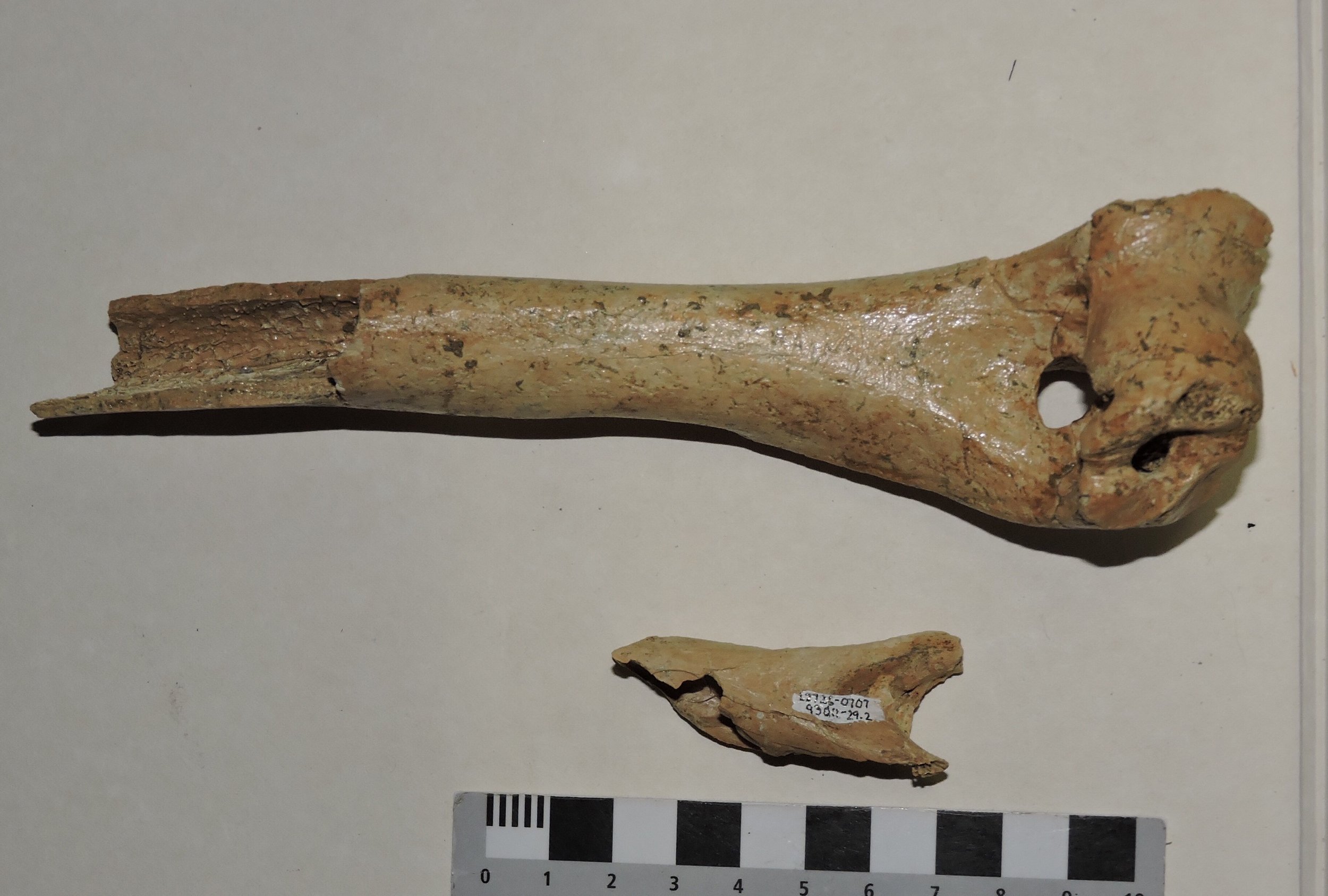 Even though this week's specimen is fragmentary, it's clearly smaller than the dire wolf. Its size is consistent with Canis latrans, the coyote. Coyotes are among the most common mammals at Rancho la Brea, and are still common in Southern California, so their presence in the Diamond Valley Lake fauna is not surprising. But it's still nice to confirm their presence, especially as modern coyotes seem to fill interesting roles in modern ecosystems. There are strong indications that modern coyotes are major predators of pronghorn, but only in the absence of wolves. Apparently wolves alter the behavior of coyotes (either by attacking them or driving them away), resulting in less overall pronghorn predation. In turn, it seems that coyotes suppress populations of domestic and feral cats, reducing predation on birds. These studies hint at the complexity of the interactions within ecosystems. With the amazing range of animals in the Diamond Valley Lake fauna there must have been some fascinating biotic interactions.
Even though this week's specimen is fragmentary, it's clearly smaller than the dire wolf. Its size is consistent with Canis latrans, the coyote. Coyotes are among the most common mammals at Rancho la Brea, and are still common in Southern California, so their presence in the Diamond Valley Lake fauna is not surprising. But it's still nice to confirm their presence, especially as modern coyotes seem to fill interesting roles in modern ecosystems. There are strong indications that modern coyotes are major predators of pronghorn, but only in the absence of wolves. Apparently wolves alter the behavior of coyotes (either by attacking them or driving them away), resulting in less overall pronghorn predation. In turn, it seems that coyotes suppress populations of domestic and feral cats, reducing predation on birds. These studies hint at the complexity of the interactions within ecosystems. With the amazing range of animals in the Diamond Valley Lake fauna there must have been some fascinating biotic interactions.
Fossil Friday - Equisetum
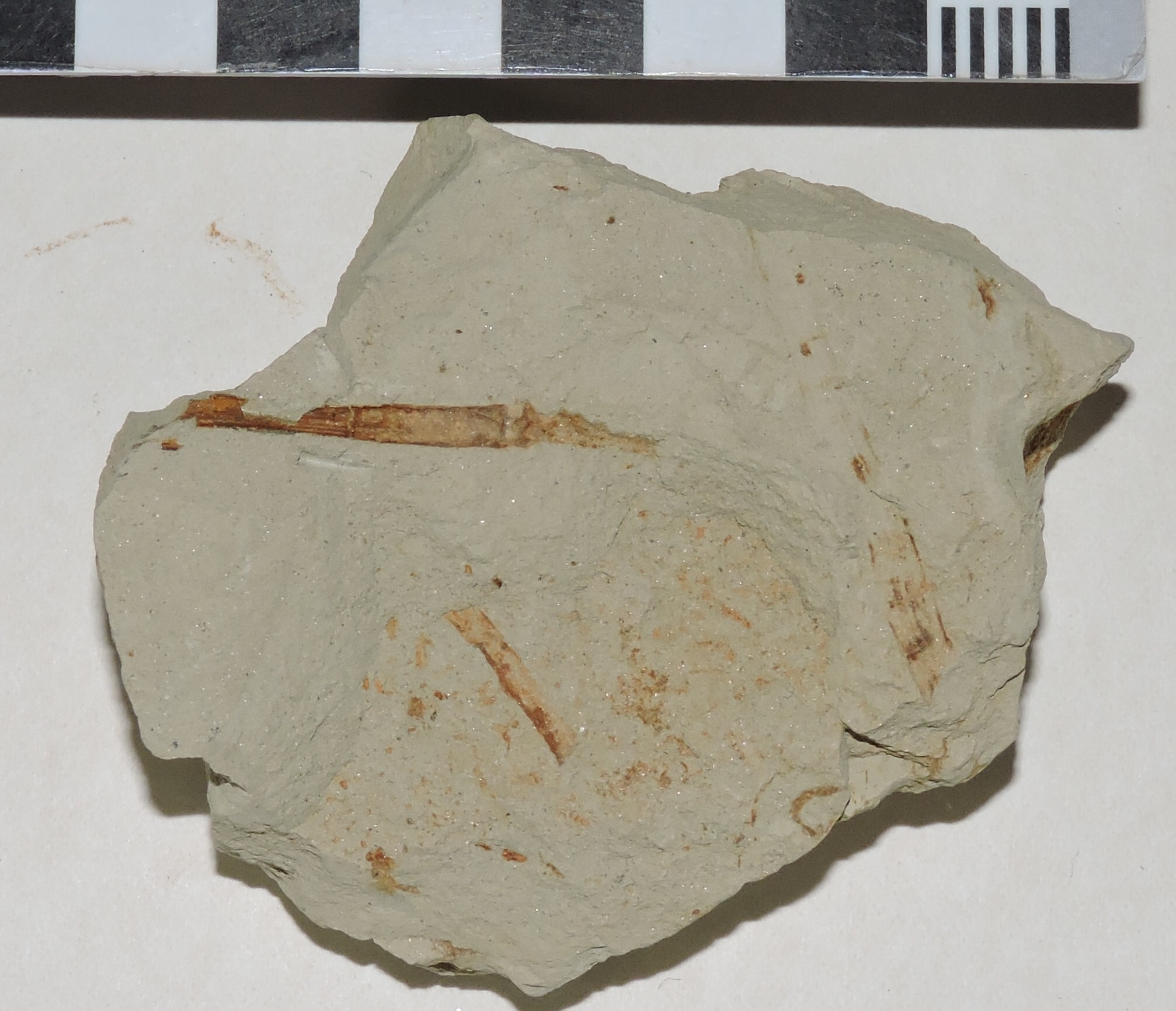 Fossil plants never seem to get the attention they deserve. Fossil animals, especially vertebrates, certainly are fascinating and have tons of things to tell us (they are, after all, what I've worked on for most of my career). But plants are exceptionally good indicators of past environmental conditions, besides being interesting organisms in their own right.Shown above is a sample of the San Timoteo Formation from northern Riverside County, specifically from the Edison El Casco Substation. This excavation yielded several thousand fossils, including plants, animals, and traces, which lived about 1.5 to 2.0 million years ago. The dark brown streaks in this sample are fragments of plant stems. While these don't look like much, there's enough here to make an identification.In the prominent stem toward the upper left, notice the fine grooves and ridges that run lengthwise along the stem (marked with the blue arrow, below). The stem also is divided into segments, marked below with the red arrows:
Fossil plants never seem to get the attention they deserve. Fossil animals, especially vertebrates, certainly are fascinating and have tons of things to tell us (they are, after all, what I've worked on for most of my career). But plants are exceptionally good indicators of past environmental conditions, besides being interesting organisms in their own right.Shown above is a sample of the San Timoteo Formation from northern Riverside County, specifically from the Edison El Casco Substation. This excavation yielded several thousand fossils, including plants, animals, and traces, which lived about 1.5 to 2.0 million years ago. The dark brown streaks in this sample are fragments of plant stems. While these don't look like much, there's enough here to make an identification.In the prominent stem toward the upper left, notice the fine grooves and ridges that run lengthwise along the stem (marked with the blue arrow, below). The stem also is divided into segments, marked below with the red arrows: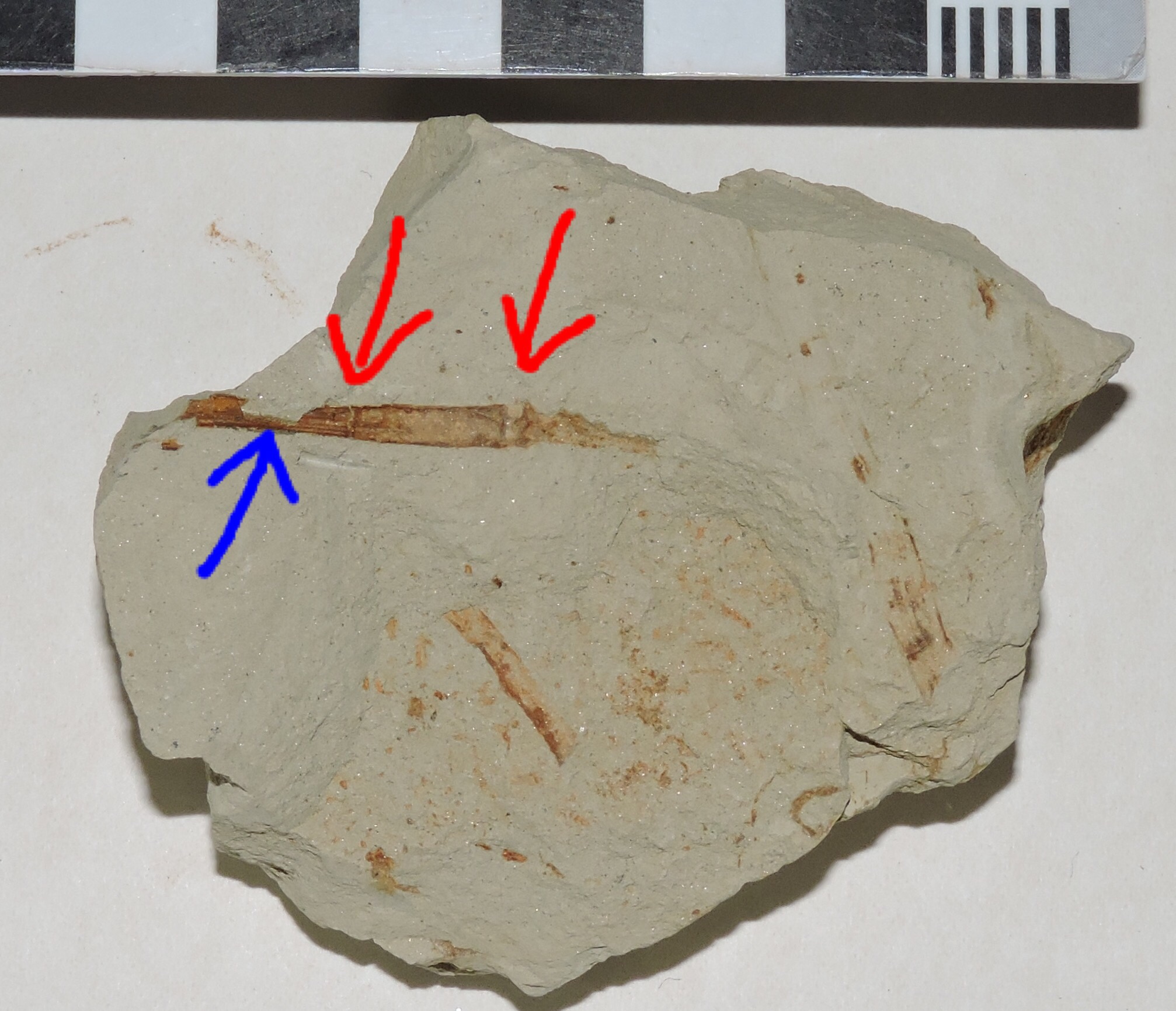 These are both characteristics of the genus Equisetum, commonly known as the horsetail or scouring rush (the latter name comes from the high silica content, which makes them useful as an abrasive). Equisetum is an interesting plant, the last survivor of a group that goes back more than 350 million years. Rather than seeds they reproduce using spores, which are released from a cone-like structure (the sporangium) at the top of the plant. (There may be an impression of a sporangium attached to the stem in this specimen, but I'm uncertain about that.) Horsetails seem to be related to ferns, and according to some genetic studies may actually be highly specialized ferns. Below are some modern examples of the whole plant (at least the above-ground portions), one of which has grown its sporangium. Notice the segmented, striated stems, just as in our fossil example:
These are both characteristics of the genus Equisetum, commonly known as the horsetail or scouring rush (the latter name comes from the high silica content, which makes them useful as an abrasive). Equisetum is an interesting plant, the last survivor of a group that goes back more than 350 million years. Rather than seeds they reproduce using spores, which are released from a cone-like structure (the sporangium) at the top of the plant. (There may be an impression of a sporangium attached to the stem in this specimen, but I'm uncertain about that.) Horsetails seem to be related to ferns, and according to some genetic studies may actually be highly specialized ferns. Below are some modern examples of the whole plant (at least the above-ground portions), one of which has grown its sporangium. Notice the segmented, striated stems, just as in our fossil example: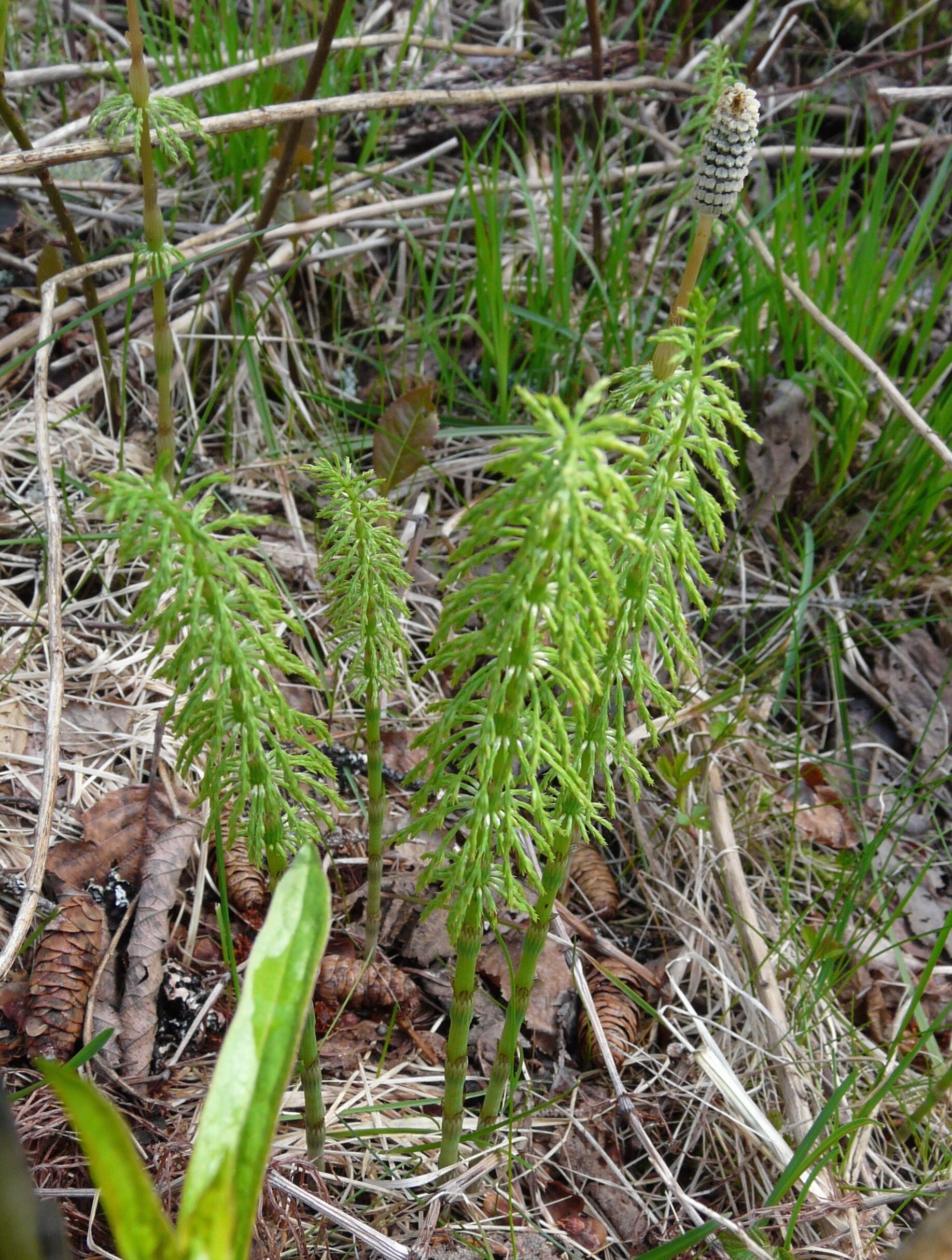 Equisetum also has interesting things to tell us about its ecosystem. Here's a group of modern Equisetum in their typical natural habitat:
Equisetum also has interesting things to tell us about its ecosystem. Here's a group of modern Equisetum in their typical natural habitat: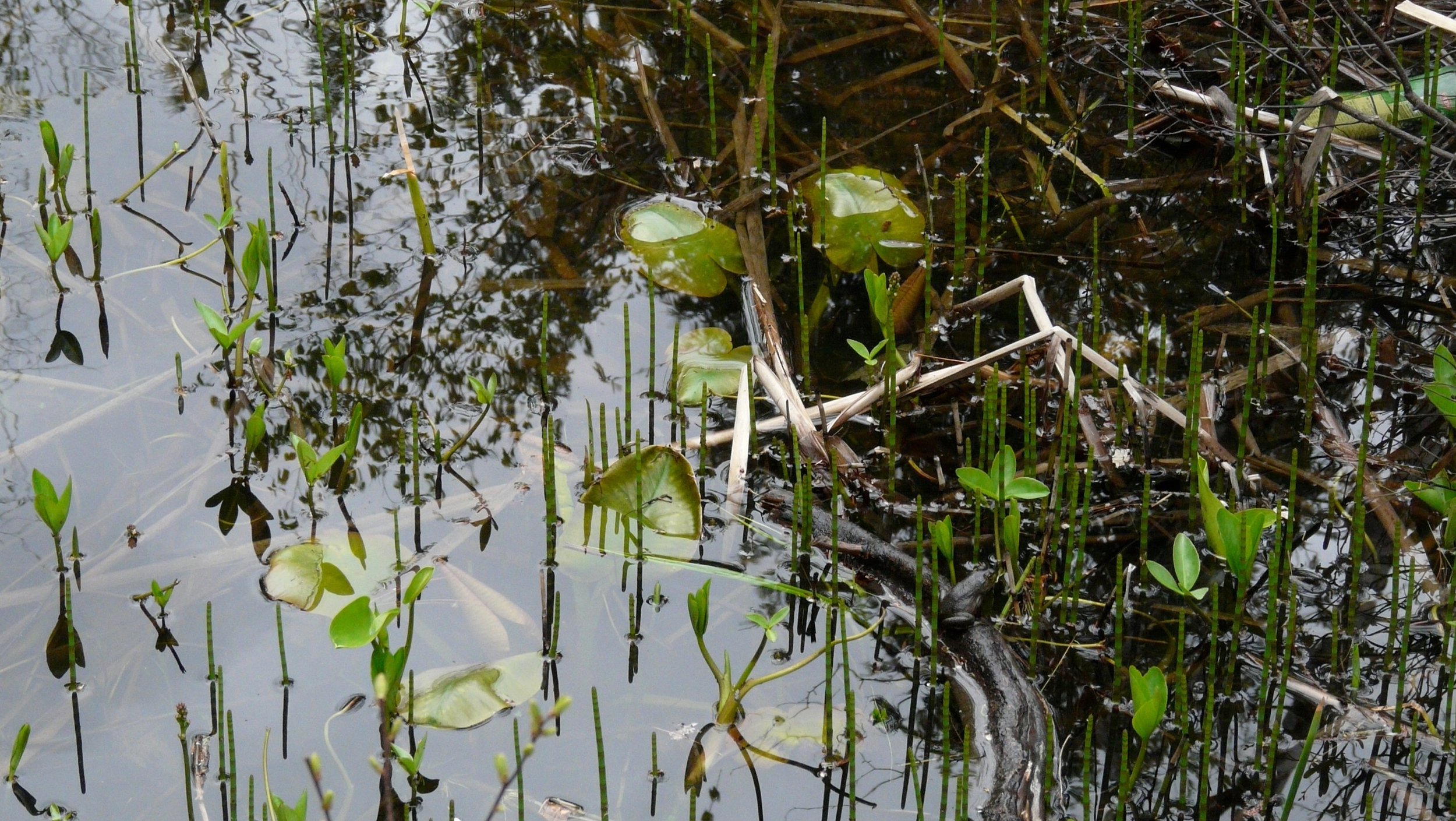 Equisetum loves water, and typically grows in or near ponds or marshes. It seems to be one of the more common plants in the El Casco Substation deposits, and is found with a number of other plant species that prefer similar conditions. This all suggests that, at least locally, conditions there were much wetter than they are today.
Equisetum loves water, and typically grows in or near ponds or marshes. It seems to be one of the more common plants in the El Casco Substation deposits, and is found with a number of other plant species that prefer similar conditions. This all suggests that, at least locally, conditions there were much wetter than they are today.
Fossil Friday - mastodon caudal vertebra
 Even in huge animals, not every bone is large. This small bone, less than 4 cm in length, comes from one of the largest Pleistocene animals at Diamond Valley Lake — a mastodon.This particular specimen is a caudal, or tail, vertebra. Its simple shape is not due to broken and missing pieces; in fact the bone is almost complete. The prominent spines and processes found sticking out on most vertebrae tend to be reduced or absent on caudal vertebrae in most animals. This is unsurprising from a functional standpoint. Those projecting spines are not simply decoration; they provide anchor points for muscles that control movement of the head, the legs, or other parts of the body. For the most part the tail doesn't serve as the anchor point for any muscles, and so the vertebrae don't generally have large processes. (There are a few exceptions: the first few caudal vertebrae have large processes that anchor the muscles that control the movement of the tail itself. There are also some animals such as alligators that have flattened tails, generally for swimming, which have enlarged caudal spines.) Their simple shape can sometimes make caudal vertebrae tricky to identify. They are sometimes mistaken for toe bones, but in most terrestrial animals even toe bones will have complex articulations and muscle attachment points that caudal vertebrae generally lack.The complete lack of processes indicates that this vertebra is from fairly close to the tip of the tail. To be that far back and still have a length of almost 4 cm indicates that it actually came from a big animal, and in fact other vertebrae associated with this bone indicate that it came from a mastodon.Looking at the bone end-on (below) we can see that the end is fairly rough:
Even in huge animals, not every bone is large. This small bone, less than 4 cm in length, comes from one of the largest Pleistocene animals at Diamond Valley Lake — a mastodon.This particular specimen is a caudal, or tail, vertebra. Its simple shape is not due to broken and missing pieces; in fact the bone is almost complete. The prominent spines and processes found sticking out on most vertebrae tend to be reduced or absent on caudal vertebrae in most animals. This is unsurprising from a functional standpoint. Those projecting spines are not simply decoration; they provide anchor points for muscles that control movement of the head, the legs, or other parts of the body. For the most part the tail doesn't serve as the anchor point for any muscles, and so the vertebrae don't generally have large processes. (There are a few exceptions: the first few caudal vertebrae have large processes that anchor the muscles that control the movement of the tail itself. There are also some animals such as alligators that have flattened tails, generally for swimming, which have enlarged caudal spines.) Their simple shape can sometimes make caudal vertebrae tricky to identify. They are sometimes mistaken for toe bones, but in most terrestrial animals even toe bones will have complex articulations and muscle attachment points that caudal vertebrae generally lack.The complete lack of processes indicates that this vertebra is from fairly close to the tip of the tail. To be that far back and still have a length of almost 4 cm indicates that it actually came from a big animal, and in fact other vertebrae associated with this bone indicate that it came from a mastodon.Looking at the bone end-on (below) we can see that the end is fairly rough: This is because the bone is missing the vertebral epiphyses, the caps of bone that fit onto each end of the vertebra. The epiphyses remain essentially as separate bones attached to the vertebra with cartilage while the animal is still growing, but eventually fuse onto the vertebra. The fusion of all the various epiphyses indicates that the animal has reached physical maturity; in elephants (and people) this is generally sometime around age 20-25. The lack of fused epiphyses in this vertebra (and, in fact, none of the epiphyses are fused and the other bones associated with this specimen) indicates that it came from a young animal, likely not more than a few years old.
This is because the bone is missing the vertebral epiphyses, the caps of bone that fit onto each end of the vertebra. The epiphyses remain essentially as separate bones attached to the vertebra with cartilage while the animal is still growing, but eventually fuse onto the vertebra. The fusion of all the various epiphyses indicates that the animal has reached physical maturity; in elephants (and people) this is generally sometime around age 20-25. The lack of fused epiphyses in this vertebra (and, in fact, none of the epiphyses are fused and the other bones associated with this specimen) indicates that it came from a young animal, likely not more than a few years old.
Fossil Friday - canid humerus
 While over 200,000 fossils were found at Diamond Valley Lake, only a tiny percentage of the specimens represent carnivores. This is actually to be expected; in any stable ecosystem prey animals always greatly outnumber their predators and so normally prey animals should be much more common as fossils. There are exceptions, such as "predator traps" like we see at Rancho la Brea, but in general the rare predator/common prey breakdown at Diamond Valley Lake is what we expect to find.That said, there is actually a fairly diverse range of predators from Diamond Valley Lake, even if most of them are known only from isolated bones like as the one shown above.This is the right humerus (upper arm bone) from a canid, the dog family. It's shown above in anterior view, with the proximal end (towards the shoulder) on the left. The proximal half of the bone is actually missing, so we only have the distal half, including the elbow joint at the right end (the condyle). The round hole through the middle of the bone near the condyle is called the supratrochlear foramen. This is a common feature in dogs, but is rare or absent in most other groups, making it a useful identification feature.Below is the medial side of the same bone, showing the sinusoidal shape that is typical of the humerus in carnivores:
While over 200,000 fossils were found at Diamond Valley Lake, only a tiny percentage of the specimens represent carnivores. This is actually to be expected; in any stable ecosystem prey animals always greatly outnumber their predators and so normally prey animals should be much more common as fossils. There are exceptions, such as "predator traps" like we see at Rancho la Brea, but in general the rare predator/common prey breakdown at Diamond Valley Lake is what we expect to find.That said, there is actually a fairly diverse range of predators from Diamond Valley Lake, even if most of them are known only from isolated bones like as the one shown above.This is the right humerus (upper arm bone) from a canid, the dog family. It's shown above in anterior view, with the proximal end (towards the shoulder) on the left. The proximal half of the bone is actually missing, so we only have the distal half, including the elbow joint at the right end (the condyle). The round hole through the middle of the bone near the condyle is called the supratrochlear foramen. This is a common feature in dogs, but is rare or absent in most other groups, making it a useful identification feature.Below is the medial side of the same bone, showing the sinusoidal shape that is typical of the humerus in carnivores: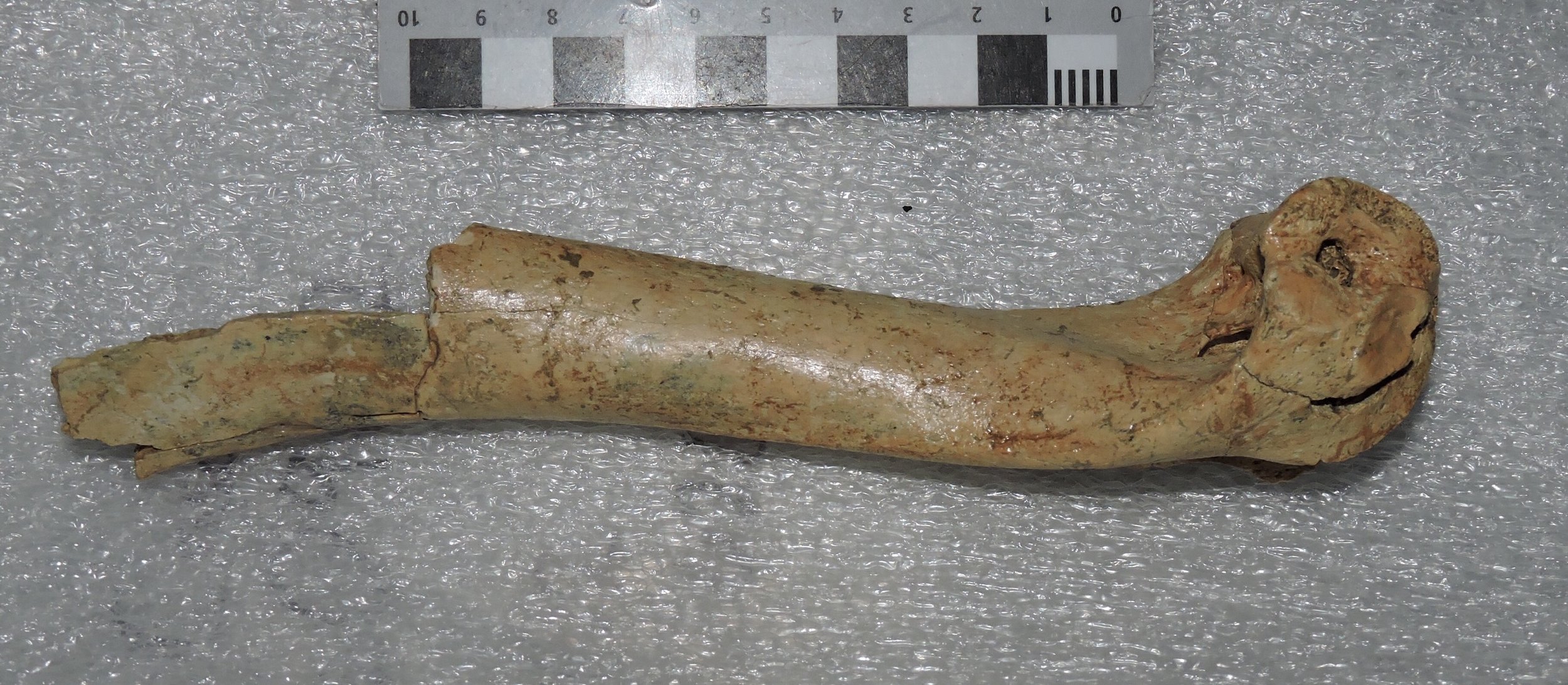 Here's the posterior view:
Here's the posterior view: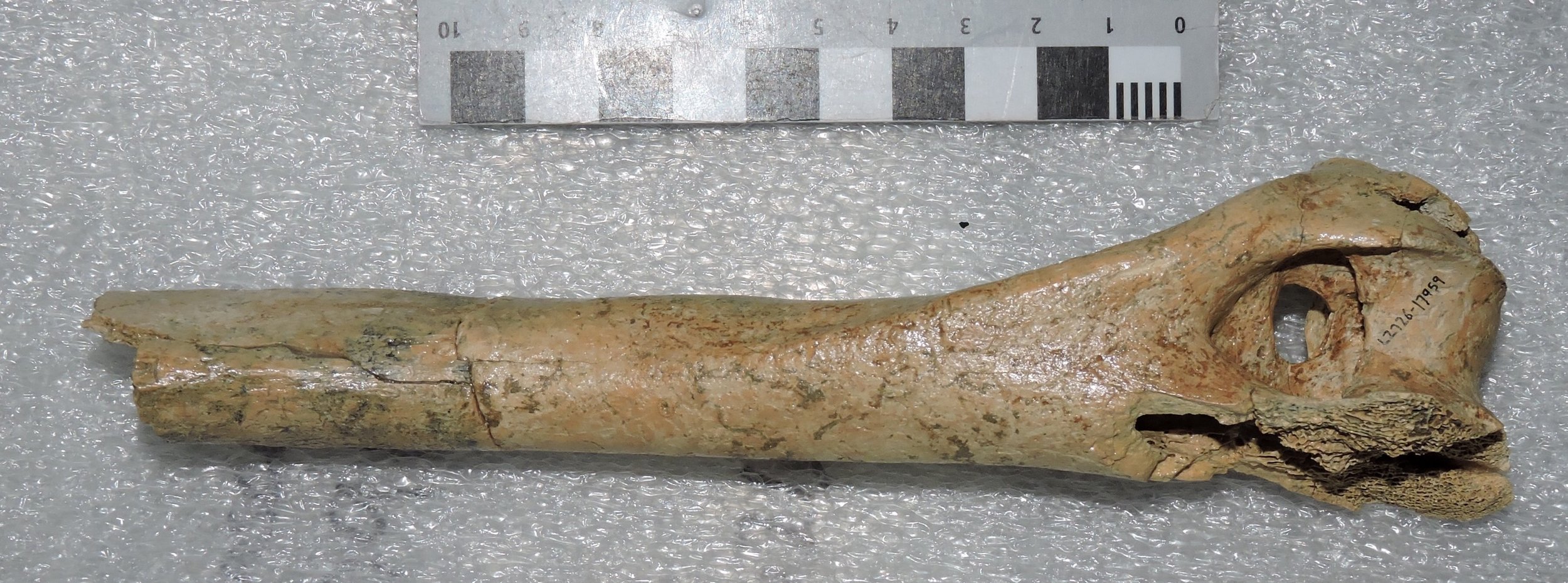 In this view the supratrochlear foramen is sitting in the bottom of a deep semi-circular depression, called the olecranon fossa. When the front leg is held straight, the olecranon process of the ulna (the "point" of the elbow) fits into this depression. This stabilizes the elbow and prevents the upper and lower arms from rotating in opposite directions along their long axes. To see how this works, hold your arm out straight, then rotate your arm like you're turning a screwdriver. Watch your elbow as you do this; you'll see that there's no rotation of the elbow at all, and that all the rotation is occurring either in the forearm and wrist, or at the shoulder.So, moving on from the anatomy, what kind of dog is this? This is actually a pretty large humerus by dog standards, and probably it's too large to be from a fox or a coyote (even the big Pleistocene coyotes). The distal end is damaged on its lateral side, but it looks like the bone was somewhere around 50-55 mm wide at the widest part of the distal end. At that size, this humerus is about right for either a small dire wolf (Canis dirus) or a large grey wolf (Canis lupus). There is other Diamond Valley Lake material that is pretty clearly from Canis dirus, but none that's definitively from Canis lupus (in fact, grey wolf fossils are extremely rare anywhere in California, if they're present at all), so a dire wolf is the more likely identification.
In this view the supratrochlear foramen is sitting in the bottom of a deep semi-circular depression, called the olecranon fossa. When the front leg is held straight, the olecranon process of the ulna (the "point" of the elbow) fits into this depression. This stabilizes the elbow and prevents the upper and lower arms from rotating in opposite directions along their long axes. To see how this works, hold your arm out straight, then rotate your arm like you're turning a screwdriver. Watch your elbow as you do this; you'll see that there's no rotation of the elbow at all, and that all the rotation is occurring either in the forearm and wrist, or at the shoulder.So, moving on from the anatomy, what kind of dog is this? This is actually a pretty large humerus by dog standards, and probably it's too large to be from a fox or a coyote (even the big Pleistocene coyotes). The distal end is damaged on its lateral side, but it looks like the bone was somewhere around 50-55 mm wide at the widest part of the distal end. At that size, this humerus is about right for either a small dire wolf (Canis dirus) or a large grey wolf (Canis lupus). There is other Diamond Valley Lake material that is pretty clearly from Canis dirus, but none that's definitively from Canis lupus (in fact, grey wolf fossils are extremely rare anywhere in California, if they're present at all), so a dire wolf is the more likely identification.
Fossil Friday - colubrids snake vertebra
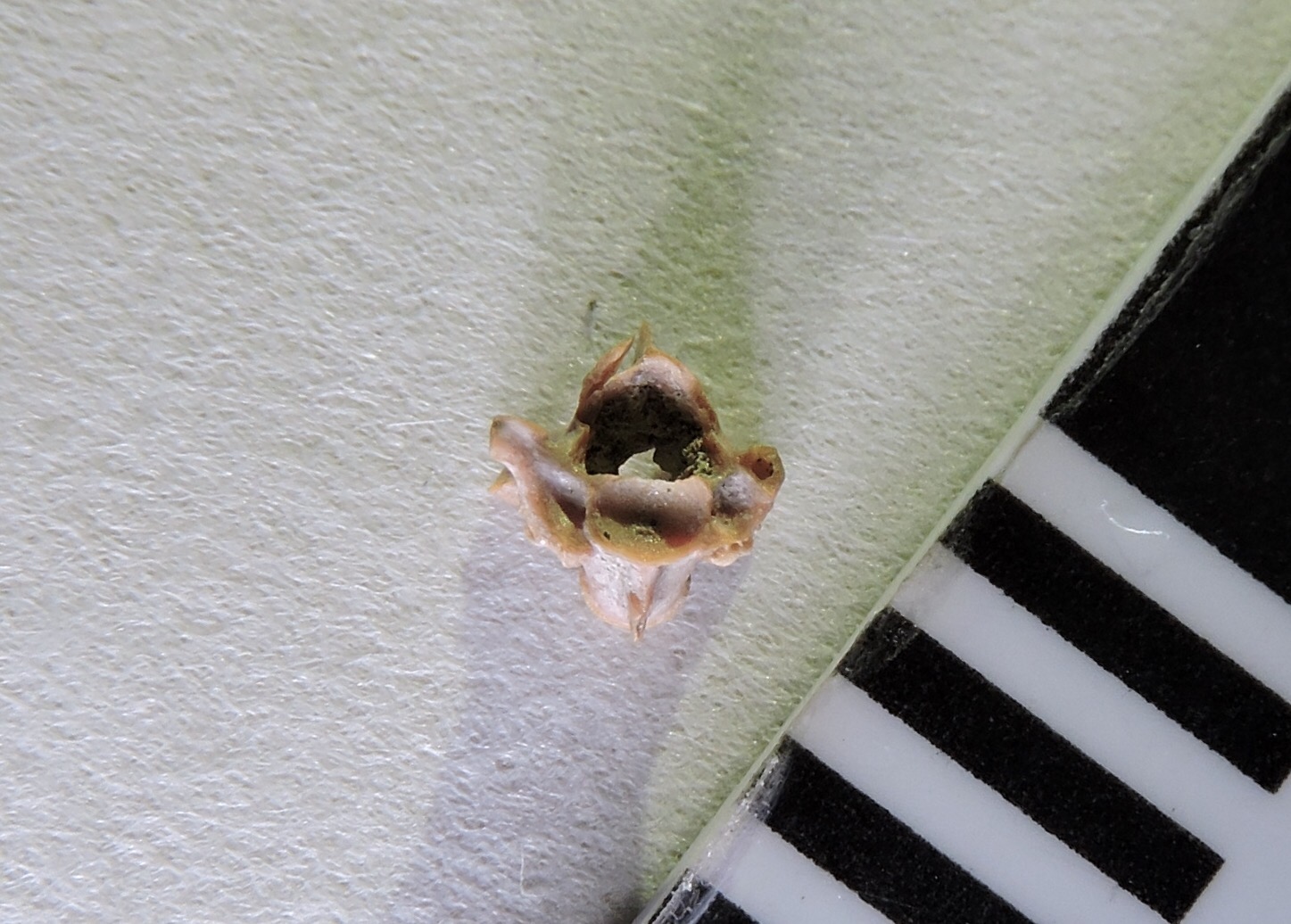 In recognition of World Snake Day (which was yesterday), for today's Fossil Friday we have a Pleistocene snake from Diamond Valley Lake.Reptiles are common in Southern California today, and the same was true during the Pleistocene, including turtles, lizards, and snakes. While rattlesnakes may get more attention, the most diverse and widespread group of snakes are the family Colubridae; in fact, more than half of the extant snake species are colubrids. With such a common group, it's not surprising that their vertebrae turn up fairly commonly as fossils.At the top of the page is a dorsal vertebra, from the region that makes up the bulk of a snake's body. The vertebra itself is about 3 millimeters across at the widest point, but in the living snake a rib would have been attached to each side. It's shown here in close to anterior view, but slightly below and to the right. Like other snakes this vertebra is procoelous, meaning that it articulates with other vertebrae in part through ball-and-socket joints. The socket on the front of the vertebra is visible here; there's a corresponding ball joint on the other end of the vertebra.Colubrids are still diverse in Southern California, and include such diverse forms as king snakes, garter snakes, and gopher snakes (such as Pituophis catanifer, below, photographed on the museum campus). With such a range of closely-related species to choose from, so far we can only say that this vertebra represents some type of colubrid.
In recognition of World Snake Day (which was yesterday), for today's Fossil Friday we have a Pleistocene snake from Diamond Valley Lake.Reptiles are common in Southern California today, and the same was true during the Pleistocene, including turtles, lizards, and snakes. While rattlesnakes may get more attention, the most diverse and widespread group of snakes are the family Colubridae; in fact, more than half of the extant snake species are colubrids. With such a common group, it's not surprising that their vertebrae turn up fairly commonly as fossils.At the top of the page is a dorsal vertebra, from the region that makes up the bulk of a snake's body. The vertebra itself is about 3 millimeters across at the widest point, but in the living snake a rib would have been attached to each side. It's shown here in close to anterior view, but slightly below and to the right. Like other snakes this vertebra is procoelous, meaning that it articulates with other vertebrae in part through ball-and-socket joints. The socket on the front of the vertebra is visible here; there's a corresponding ball joint on the other end of the vertebra.Colubrids are still diverse in Southern California, and include such diverse forms as king snakes, garter snakes, and gopher snakes (such as Pituophis catanifer, below, photographed on the museum campus). With such a range of closely-related species to choose from, so far we can only say that this vertebra represents some type of colubrid.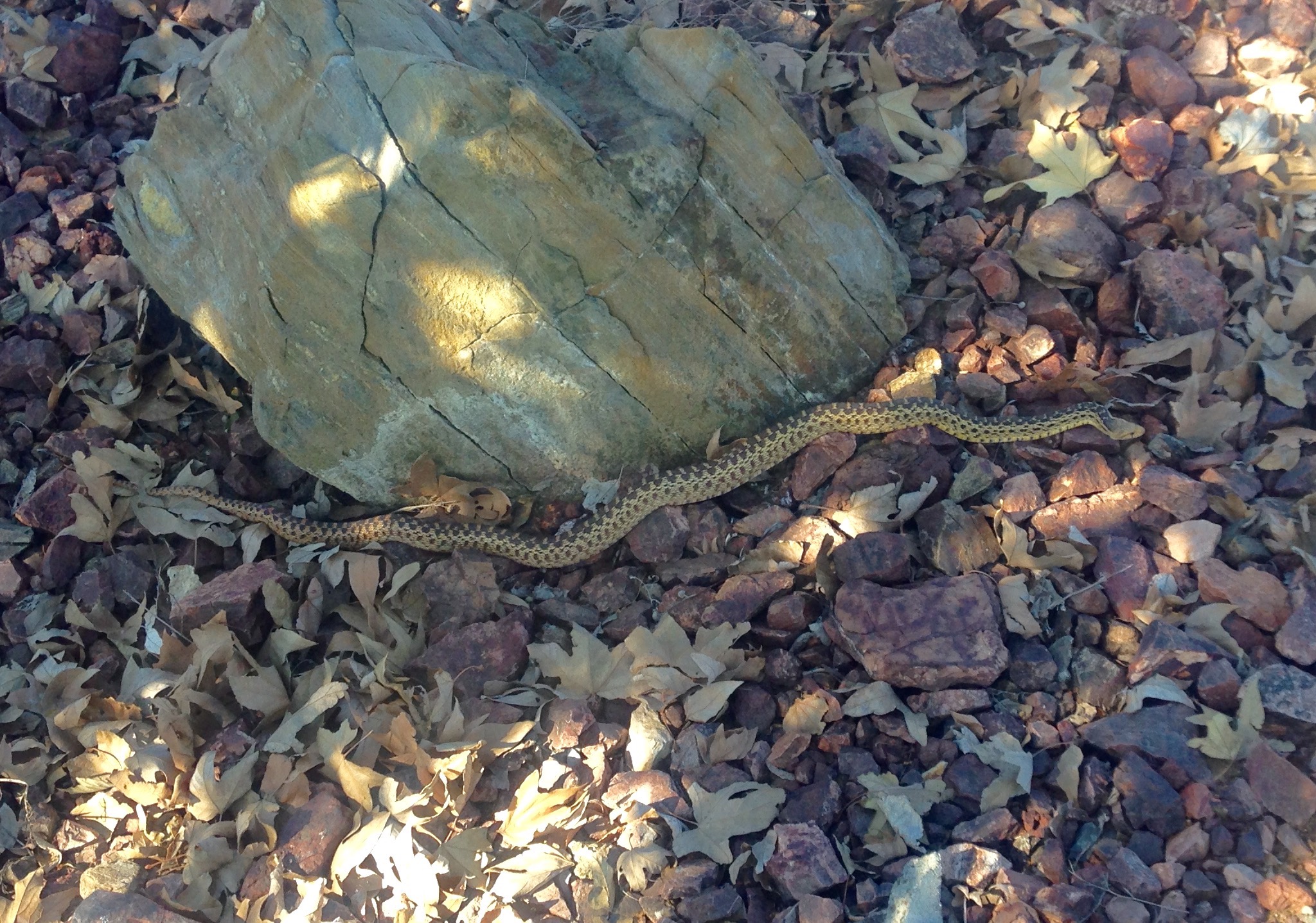
Fossil Friday - quail hand
 When studying comparative anatomy, one of the most basic skills is identifying homologous structures - the same bone or organ in different organisms. This can be tricky, as a structure may become hugely modified in the course of evolution as it is co-opted for new purposes. The bird's wing provides a classic example.Birds' wings are modified forelimbs, and as such have the same basic components as any other tetrapod's forelimb, including a wrist and hand. A typical tetrapod hand commonly has five bones called metacarpals, that articulate at the proximal ends with a series of small bones called the carpals (wrist bones). In birds there are only three metacarpals, a trait they inherited from their theropod dinosaur ancestors. Moreover, most of the bird carpals and the metacarpals are fused together into a single structure called the carpometacarpus.At the top of the page is a partial carpometacarpus from the Pleistocene deposits at Diamond Valley Lake. This represents part of the proximal end (the wrist end) of a small right carpometacarpus (the small scale increments are millimeters). The long shaft is the 2nd metacarpal, the hand bone associated with the index finger. Even in such a small fragment several features are visible, such as those indicated below:
When studying comparative anatomy, one of the most basic skills is identifying homologous structures - the same bone or organ in different organisms. This can be tricky, as a structure may become hugely modified in the course of evolution as it is co-opted for new purposes. The bird's wing provides a classic example.Birds' wings are modified forelimbs, and as such have the same basic components as any other tetrapod's forelimb, including a wrist and hand. A typical tetrapod hand commonly has five bones called metacarpals, that articulate at the proximal ends with a series of small bones called the carpals (wrist bones). In birds there are only three metacarpals, a trait they inherited from their theropod dinosaur ancestors. Moreover, most of the bird carpals and the metacarpals are fused together into a single structure called the carpometacarpus.At the top of the page is a partial carpometacarpus from the Pleistocene deposits at Diamond Valley Lake. This represents part of the proximal end (the wrist end) of a small right carpometacarpus (the small scale increments are millimeters). The long shaft is the 2nd metacarpal, the hand bone associated with the index finger. Even in such a small fragment several features are visible, such as those indicated below: The projection marked "1" is the 1st metacarpal, the one associated with the thumb; in birds it it reduced and solidly fused to the carpals. The thumb bone, which is called the alula in birds and supports feathers on the leading edge of the wing, articulates at this point.Number "2" is the broken base of the 3rd metacarpal, the one associated with the middle finger. Birds don't have the 4th and 5th metacarpals, the ones associated with the ring and pinky fingers; these were lost in bird ancestors millions of years before the first birds appear in the fossil record.Number "3" is called the intermetacarpal tuberosity; it's a bony spur of metacarpal 2 that projects into the gap between metacarpals 2 and 3. In this specimen, the tuberosity is very large relative to the size of the metacarpal. That's significant, because such a large tuberosity is generally only present in a group of birds called the Galliformes (turkeys, chickens, quails, and their relatives). The size and shape of this particular bone suggests that belongs to a New World quail from the genus Callipepla.Callipepla is still a common bird in southern California, with two different species considered to be native to the area. Callipepla californica is California's official state bird, and C. gambelii is also common in this area (below is C. gambelii from the North Carolina Zoo) . Two other species of Callipepla are found in the southwestern United States or northern Mexico but not currently in California. With such a fragmentary specimen, any of these closely related species are a possibilities for this Diamond Valley Lake specimen. We have a number of Callipepla bones in the collection, suggesting that, like today, quail were a common component of the Diamond Valley Lake fauna during the Pleistocene.
The projection marked "1" is the 1st metacarpal, the one associated with the thumb; in birds it it reduced and solidly fused to the carpals. The thumb bone, which is called the alula in birds and supports feathers on the leading edge of the wing, articulates at this point.Number "2" is the broken base of the 3rd metacarpal, the one associated with the middle finger. Birds don't have the 4th and 5th metacarpals, the ones associated with the ring and pinky fingers; these were lost in bird ancestors millions of years before the first birds appear in the fossil record.Number "3" is called the intermetacarpal tuberosity; it's a bony spur of metacarpal 2 that projects into the gap between metacarpals 2 and 3. In this specimen, the tuberosity is very large relative to the size of the metacarpal. That's significant, because such a large tuberosity is generally only present in a group of birds called the Galliformes (turkeys, chickens, quails, and their relatives). The size and shape of this particular bone suggests that belongs to a New World quail from the genus Callipepla.Callipepla is still a common bird in southern California, with two different species considered to be native to the area. Callipepla californica is California's official state bird, and C. gambelii is also common in this area (below is C. gambelii from the North Carolina Zoo) . Two other species of Callipepla are found in the southwestern United States or northern Mexico but not currently in California. With such a fragmentary specimen, any of these closely related species are a possibilities for this Diamond Valley Lake specimen. We have a number of Callipepla bones in the collection, suggesting that, like today, quail were a common component of the Diamond Valley Lake fauna during the Pleistocene.
Fossil Friday - Jefferson's ground sloth
 Tomorrow the United States celebrates Independence Day, commemorating the signing in 1776 of the Declaration of Independence. The primary author of the Declaration was Thomas Jefferson, who went on to hold various U.S. government office including vice-president and president. But in addition to his role in the founding of the United States, Jefferson played a major part in the development of paleontology in North America.In 1797, while he was vice-president, Jefferson presented a paper to the American Philosophical Society (published in 1799) reporting on bones that had been found in a cave in Virginia (now in West Virginia):
Tomorrow the United States celebrates Independence Day, commemorating the signing in 1776 of the Declaration of Independence. The primary author of the Declaration was Thomas Jefferson, who went on to hold various U.S. government office including vice-president and president. But in addition to his role in the founding of the United States, Jefferson played a major part in the development of paleontology in North America.In 1797, while he was vice-president, Jefferson presented a paper to the American Philosophical Society (published in 1799) reporting on bones that had been found in a cave in Virginia (now in West Virginia): Only a small number of bones were recovered, but these included three huge claws. Jefferson believed that the bones represented a type of giant lion, and proposed the name Megalonyx ("giant claw") for the newly discovered animal. It turned out that Jefferson's identification was incorrect. Two years later, Caspar Wistar correctly identified the bones as coming from a ground sloth. In 1822, A. G. Desmarest established the specific name jeffersonii for this species.While fossils from the Americas had of course been discovered and even figured in publications as early as the late 1600’s, very little scientific work on American fossils was published through the 1700’s. This changed starting in the early 1800’s, and Thomas Jefferson's publication of Megalonyx is often taken as marking the beginning of vertebrate paleontology in North America.Besides its historical importance, Megalonyx is a really interesting animal in its own right. It's a medium-sized ground sloth, up to about 3 m in length (some ground sloths were huge!). It's only distantly related to most other famous ground sloths such as Eremotherium and Paramylodon, and is in fact more closely related to the extant two-toed tree sloth Choloepus. Megalonyx was also the most wide-ranging of the ground sloths; while their remains are most common in the eastern U.S. they have been found from Florida to Alaska. A few specimens are also known from California, including a handful of bones from Diamond Valley Lake that are on public display at the Western Science Center. At the top of the page is a mandible, shown in dorsal view, with the same bone shown below in left lateral view:
Only a small number of bones were recovered, but these included three huge claws. Jefferson believed that the bones represented a type of giant lion, and proposed the name Megalonyx ("giant claw") for the newly discovered animal. It turned out that Jefferson's identification was incorrect. Two years later, Caspar Wistar correctly identified the bones as coming from a ground sloth. In 1822, A. G. Desmarest established the specific name jeffersonii for this species.While fossils from the Americas had of course been discovered and even figured in publications as early as the late 1600’s, very little scientific work on American fossils was published through the 1700’s. This changed starting in the early 1800’s, and Thomas Jefferson's publication of Megalonyx is often taken as marking the beginning of vertebrate paleontology in North America.Besides its historical importance, Megalonyx is a really interesting animal in its own right. It's a medium-sized ground sloth, up to about 3 m in length (some ground sloths were huge!). It's only distantly related to most other famous ground sloths such as Eremotherium and Paramylodon, and is in fact more closely related to the extant two-toed tree sloth Choloepus. Megalonyx was also the most wide-ranging of the ground sloths; while their remains are most common in the eastern U.S. they have been found from Florida to Alaska. A few specimens are also known from California, including a handful of bones from Diamond Valley Lake that are on public display at the Western Science Center. At the top of the page is a mandible, shown in dorsal view, with the same bone shown below in left lateral view:  Only eight Megalonyx bones were recovered from the Diamond Valley and Domenigoni Valley excavations, but this still shows that Jefferson's ground sloth was roaming across California during the Pleistocene.References:Desmarest, A. G. 1822. Mammalogie, ou, description des espèces de mammifères, Chez Mme. Vueve Agasse, imprimeur-libaire, Paris.Jefferson, T. 1799. A memoir on the discovery of certain bones of a quadruped of the clawed kind in the western parts of Virginia. Transactions of the American Philosophical Society, 4:246-260.Wistar, C. 1799. A description of the bones deposited, by the President, in the museum of the society, and represented in the annexed plates. Transactions of the American Philosophical Society, p. 526-531.
Only eight Megalonyx bones were recovered from the Diamond Valley and Domenigoni Valley excavations, but this still shows that Jefferson's ground sloth was roaming across California during the Pleistocene.References:Desmarest, A. G. 1822. Mammalogie, ou, description des espèces de mammifères, Chez Mme. Vueve Agasse, imprimeur-libaire, Paris.Jefferson, T. 1799. A memoir on the discovery of certain bones of a quadruped of the clawed kind in the western parts of Virginia. Transactions of the American Philosophical Society, 4:246-260.Wistar, C. 1799. A description of the bones deposited, by the President, in the museum of the society, and represented in the annexed plates. Transactions of the American Philosophical Society, p. 526-531.
Fossil Friday - wildfires
 A large wildfire, called the "Lake Fire", is currently burning in the San Bernardino National Forest. Even though the fire is about 50 km north of Hemet, smoke from the fire is clearly visible from the Western Science Center.Wildfires such as this are widespread in Southern California during the summer, driven by dry vegetation and frequent afternoon and evening winds. The regularity of these fires is evident in the fleet of Cal Fire aerial tankers based at the Hemet Airport, which are currently making regular flights to combat the Lake Fire:
A large wildfire, called the "Lake Fire", is currently burning in the San Bernardino National Forest. Even though the fire is about 50 km north of Hemet, smoke from the fire is clearly visible from the Western Science Center.Wildfires such as this are widespread in Southern California during the summer, driven by dry vegetation and frequent afternoon and evening winds. The regularity of these fires is evident in the fleet of Cal Fire aerial tankers based at the Hemet Airport, which are currently making regular flights to combat the Lake Fire: Anthropogenic climate change and the ongoing drought have resulted in ideal conditions for wildfires in this area, but wildfires are not a new occurrence in California. In fact, a quick records search of the Diamond Valley Lake fossil collection housed at the museum turned up at least 80 Pleistocene specimens that show evidence of burning. The DVL fossils all predate the arrival of humans in California, so these aren't animals that were cooked for food. They represent animals that were exposed to wildfire at or fairly close to the time of death.In some cases the evidence for burning is subtle, but in others there is no room for doubt:
Anthropogenic climate change and the ongoing drought have resulted in ideal conditions for wildfires in this area, but wildfires are not a new occurrence in California. In fact, a quick records search of the Diamond Valley Lake fossil collection housed at the museum turned up at least 80 Pleistocene specimens that show evidence of burning. The DVL fossils all predate the arrival of humans in California, so these aren't animals that were cooked for food. They represent animals that were exposed to wildfire at or fairly close to the time of death.In some cases the evidence for burning is subtle, but in others there is no room for doubt:
 Above are two views of the left tibia (shin bone) of the camel Camelops. Most of the bone is missing, with only the distal end preserved (there is also a box full of associated fragments). The bone is completely burned, inside and out, and has almost a charcoal-like texture on the surface. The burning extends to the broken surface, so presumably the bone was broken when it burned. It's possible that the bone had been exposed on the ground for awhile and had already started cracking up when the fire came through, but it's also possible that a relatively fresh bone cracked and broke due to the heat from the fire. Regardless, specimens like this show that, much like today, wildfires were a regular occurrence in Southern California during the Pleistocene.
Above are two views of the left tibia (shin bone) of the camel Camelops. Most of the bone is missing, with only the distal end preserved (there is also a box full of associated fragments). The bone is completely burned, inside and out, and has almost a charcoal-like texture on the surface. The burning extends to the broken surface, so presumably the bone was broken when it burned. It's possible that the bone had been exposed on the ground for awhile and had already started cracking up when the fire came through, but it's also possible that a relatively fresh bone cracked and broke due to the heat from the fire. Regardless, specimens like this show that, much like today, wildfires were a regular occurrence in Southern California during the Pleistocene.
Fossil Friday - bison metacarpal
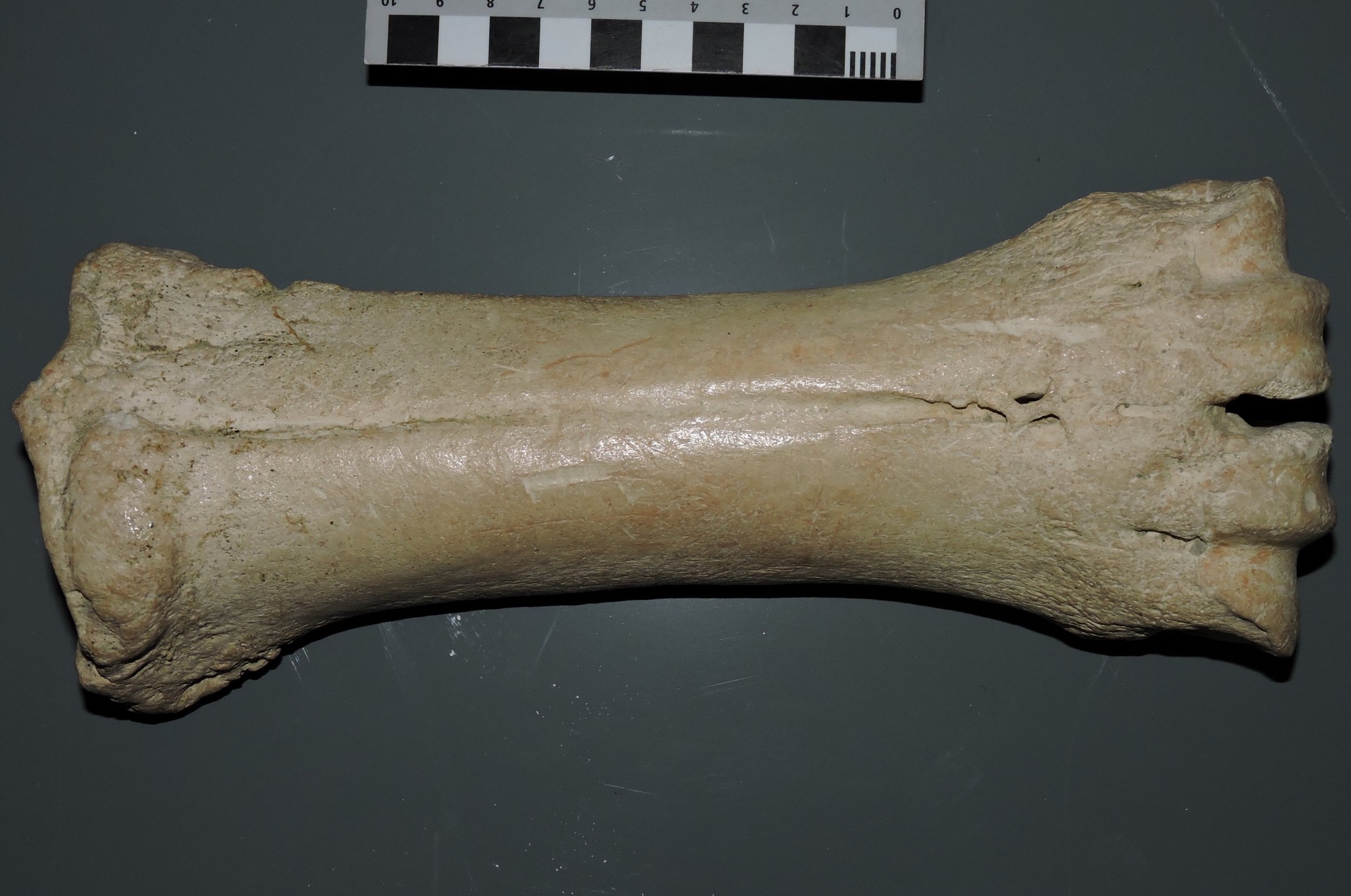 This week's Fossil Friday features a metacarpal (hand bone) from a Pleistocene bison. The example shown here is a left metacarpal shown in anterior view, with the proximal end (at the wrist) on the left and the distal end (at the first knuckles) on the right.Like many other advanced artiodactyls, in bison this structure is actually two bones that are fused together. These are the third and fourth metacarpals, the hand bones that in humans support the middle finger (Digit III) and the ring finger (Digit IV). Both of these "fingers" are present in bison as well, with each supporting a hoof (remember that our hands are just highly modified front feet). The articulations for each digit are visible at the distal end of the bone, on the right side of the picture.Here's the same bone in posterior view (the equivalent of "palmar view" in a human hand):
This week's Fossil Friday features a metacarpal (hand bone) from a Pleistocene bison. The example shown here is a left metacarpal shown in anterior view, with the proximal end (at the wrist) on the left and the distal end (at the first knuckles) on the right.Like many other advanced artiodactyls, in bison this structure is actually two bones that are fused together. These are the third and fourth metacarpals, the hand bones that in humans support the middle finger (Digit III) and the ring finger (Digit IV). Both of these "fingers" are present in bison as well, with each supporting a hoof (remember that our hands are just highly modified front feet). The articulations for each digit are visible at the distal end of the bone, on the right side of the picture.Here's the same bone in posterior view (the equivalent of "palmar view" in a human hand):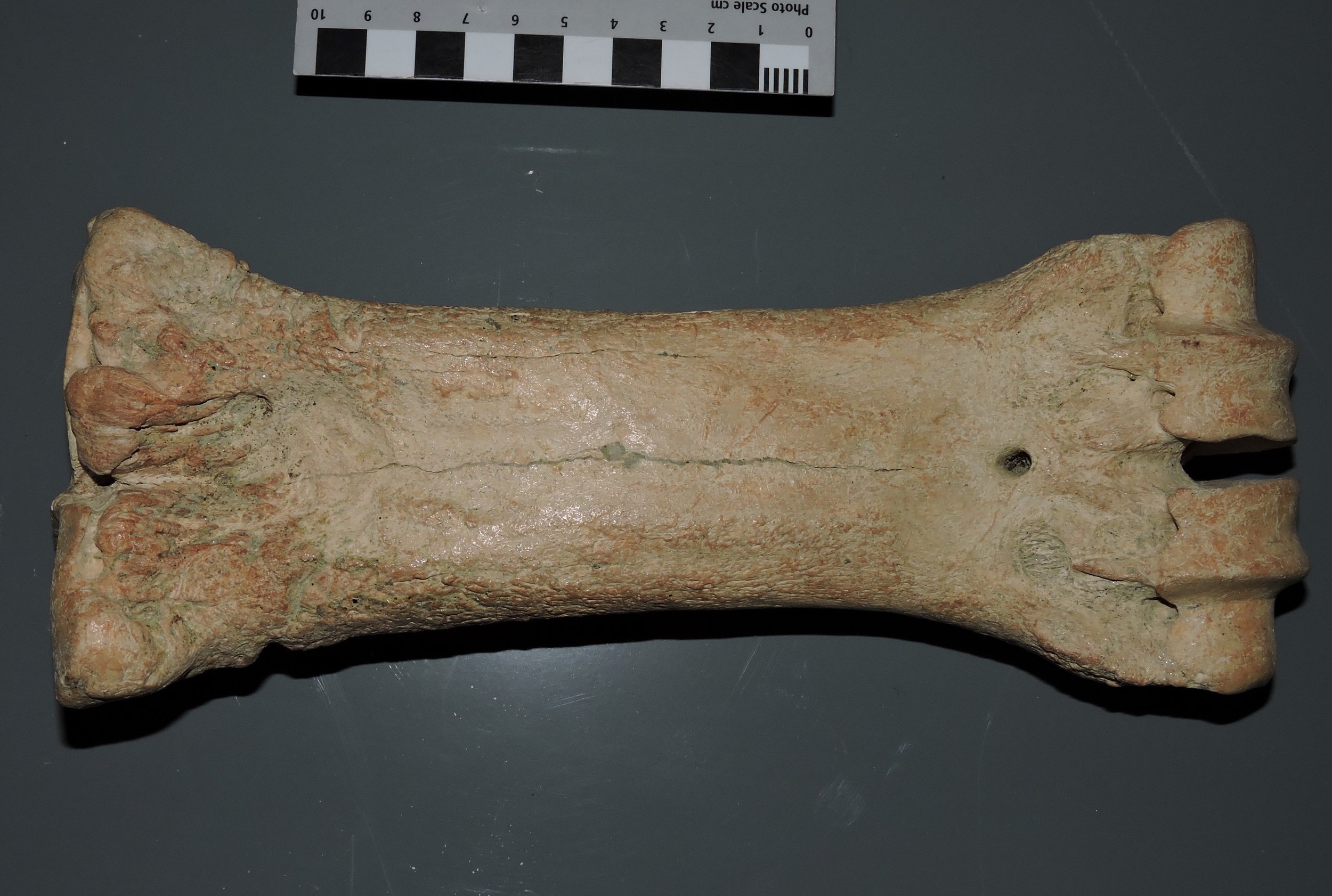 In this view the articulations for digits III and IV are more clearly visible on the right, but the groove indicating the line of fusion between the third and fourth metacarpals is almost completely lost.Last year I posted photos of the metacarpal from the extinct camel Camelops. Camels and bison are not very closely related to each other, but they are both artiodactyls that show similarities is the hand and foot structure. In both animals the front foot is reduced to just the fused third and fourth metacarpals. Camelops was a large animal that was much taller than Bison, and this is reflected by the relatively long, slender metacarpal. Bison, while shorter, were heavier and had to support a massive head, resulting in a shorter, stouter metacarpal.
In this view the articulations for digits III and IV are more clearly visible on the right, but the groove indicating the line of fusion between the third and fourth metacarpals is almost completely lost.Last year I posted photos of the metacarpal from the extinct camel Camelops. Camels and bison are not very closely related to each other, but they are both artiodactyls that show similarities is the hand and foot structure. In both animals the front foot is reduced to just the fused third and fourth metacarpals. Camelops was a large animal that was much taller than Bison, and this is reflected by the relatively long, slender metacarpal. Bison, while shorter, were heavier and had to support a massive head, resulting in a shorter, stouter metacarpal.
Fossil Friday - eagle talon (or, a Pleistocene dinosaur)
 With the release of Jurassic World, we've been getting some inquiries from the media about what dinosaurs the Western Science Center has in our collections. While we have a small number of isolated bones and teeth from the Cretaceous Hell Creek Formation in Montana, the answer that they really don't like to hear is that we have lots of dinosaurs, because we have lots of birds.In general, the paleontological community's reaction to Jurassic World has been disappointment at best (disclosure: I haven't seen the movie, and have no immediate plans to do so). The problem is that, while the original Jurassic Park movie had a lot of errors, it did a pretty good job of portraying dinosaurs based on our scientific knowledge at the time. But we've learned a lot more in the 20+ years since, and Jurassic World doesn't reflect that; in fact, in some ways it seems to be a huge step backwards even relative to Jurassic Park. One of the key points where Jurassic World fails is in it's failure to use birds as a model for reconstructing dinosaurs. Whether or not the Jurassic World designers like to admit it, birds are the last surviving branch of dinosaurs. They also happen to be a highly successful branch; there are roughly twice as many modern species of birds as there are of mammals. Even though birds have a relatively low preservation potential due to their fragile bones, with such a successful and widespread group we would expect them to show up fairly commonly as fossils. In fact, we have quite a few species of Pleistocene birds represented in the Diamond Valley Lake fauna. These are almost all based on isolated bones, such as the eagle talon shown at the top of the page. I'm not sure what species this talon represents, but a good possibility is a golden eagle, Aqulia chrysaetos (modern example below from the Nashville Zoo):
With the release of Jurassic World, we've been getting some inquiries from the media about what dinosaurs the Western Science Center has in our collections. While we have a small number of isolated bones and teeth from the Cretaceous Hell Creek Formation in Montana, the answer that they really don't like to hear is that we have lots of dinosaurs, because we have lots of birds.In general, the paleontological community's reaction to Jurassic World has been disappointment at best (disclosure: I haven't seen the movie, and have no immediate plans to do so). The problem is that, while the original Jurassic Park movie had a lot of errors, it did a pretty good job of portraying dinosaurs based on our scientific knowledge at the time. But we've learned a lot more in the 20+ years since, and Jurassic World doesn't reflect that; in fact, in some ways it seems to be a huge step backwards even relative to Jurassic Park. One of the key points where Jurassic World fails is in it's failure to use birds as a model for reconstructing dinosaurs. Whether or not the Jurassic World designers like to admit it, birds are the last surviving branch of dinosaurs. They also happen to be a highly successful branch; there are roughly twice as many modern species of birds as there are of mammals. Even though birds have a relatively low preservation potential due to their fragile bones, with such a successful and widespread group we would expect them to show up fairly commonly as fossils. In fact, we have quite a few species of Pleistocene birds represented in the Diamond Valley Lake fauna. These are almost all based on isolated bones, such as the eagle talon shown at the top of the page. I'm not sure what species this talon represents, but a good possibility is a golden eagle, Aqulia chrysaetos (modern example below from the Nashville Zoo):  Golden eagles were widespread in California during the Pleistocene; in fact, they are the most common animal at the Pleistocene tar pits at Rancho la Brea, and there are several specimens in the Diamond Valley Lake fauna. So, Jurassic World aside, California dinosaurs are alive and well!
Golden eagles were widespread in California during the Pleistocene; in fact, they are the most common animal at the Pleistocene tar pits at Rancho la Brea, and there are several specimens in the Diamond Valley Lake fauna. So, Jurassic World aside, California dinosaurs are alive and well!

